Reviewer's Note: The ACE-G and A10-G were provided by Tiablo for review.
Warning: very pic heavy, nearly 60 images
UPDATE 5/8/2009: Based on output results presented here, Tiablo realized that there was an issue with the performance of the ACE-G. They were able to revise the circuit before shipping to improve output by nearly 50% with equivalent runtime. oo: This review has been updated with pics and runtimes of the new currently-shipping ACE-G. :thumbsup:
oo: This review has been updated with pics and runtimes of the new currently-shipping ACE-G. :thumbsup:
UPDATE 4/28/2009: Added beamshots and runtimes of the JetBeam M1X to the ACE-G comparison portion of this review (Part III).
Tiablo made a bit of splash with their return to the thrower market last year with the A10 (and subsequent ACE, which used the same build but with a quad-die MC-E emitter). I hadn't previously reviewed those lights, but Tiablo has sent be the revised A10-G and ACE-G for comparative review (the "-G" refers to revised size to fit the standard 1-inch diameter of most gun mounts).
Since there are a lot of build similarities, I thought I would cover these two lights together in one massive multi-part review. In the first section (Part I), I will describe the common build features (and differences) of the two lights. In Part II, I will give a detailed comparison of the A10-G to other throwers. And in Part III, I will examine the ACE-G in detail.
-----------------------
PART I - Overview of the A10-G/ACE-G
You will find detailed specs in the Tiablo sales thread for these lights and in Parts II & III of this review, but here is a brief summary of what has changed from the previous generation A10/ACE:
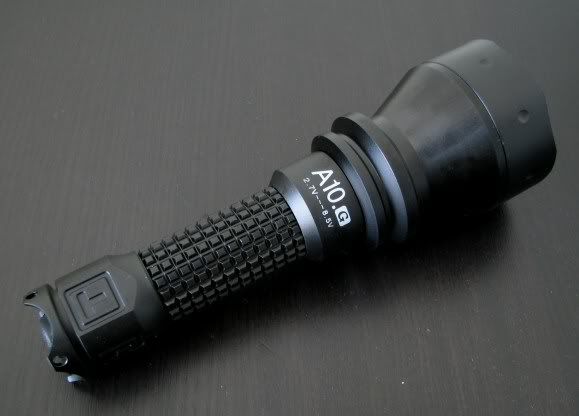
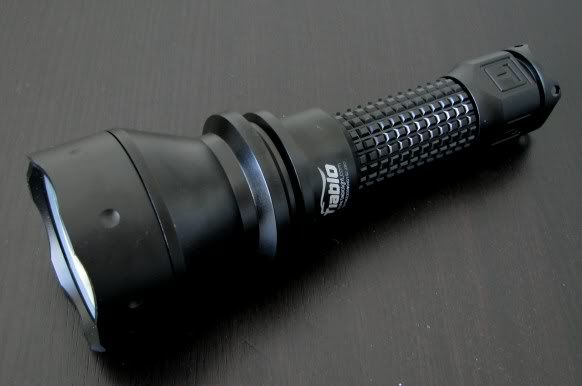
From the outside, the A10-G and ACE-G look indistinguishable. The body parts (except for the reflector and emitter/pill) are generally interchangeable between the models. The ACE-G comes with one free battery extender tube, allowing you to use 2x18650 (although additional extenders are available - for up to 4x18650! oo
oo
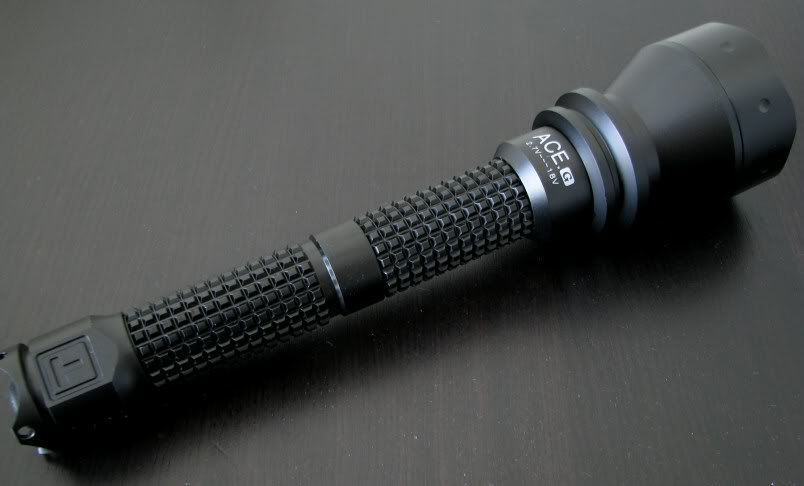
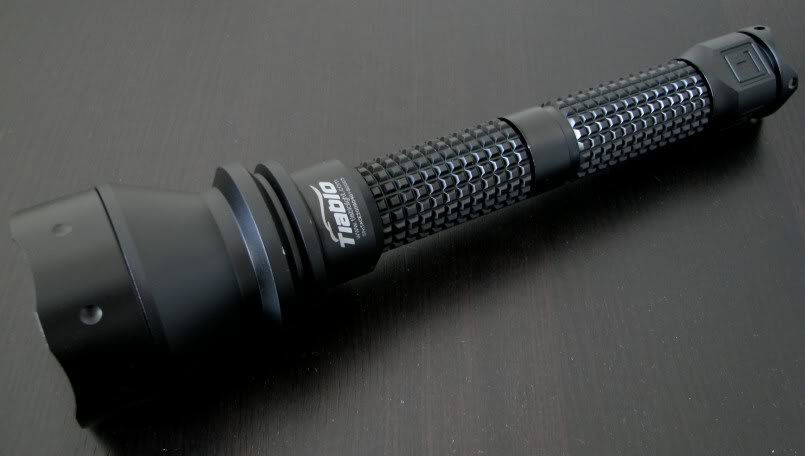
The use of a raised checkered pattern (instead of traditional knurling) is an interesting way to enhance grip. Similar to the Olight M20, but more aggressive in this case (i.e. more raised). The battery extenders for the ACE-G now match the rest of the body design.
The lights come in black type-III (hard anodized) finish. The lettering is clear and sharp on my samples (although could be a bit brighter on the small print).
I will cover the comparisons to other lights of their respective classes in Parts II & III, but here's how they look in hand: (note for all the pics below, the A10-G is always shown first, followed by the ACE-G)
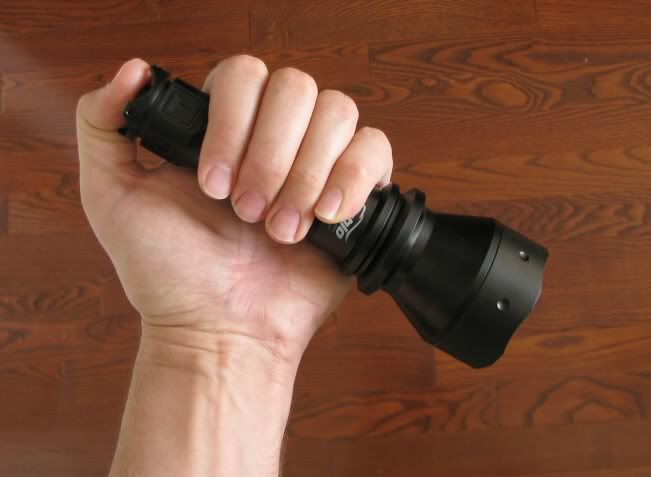
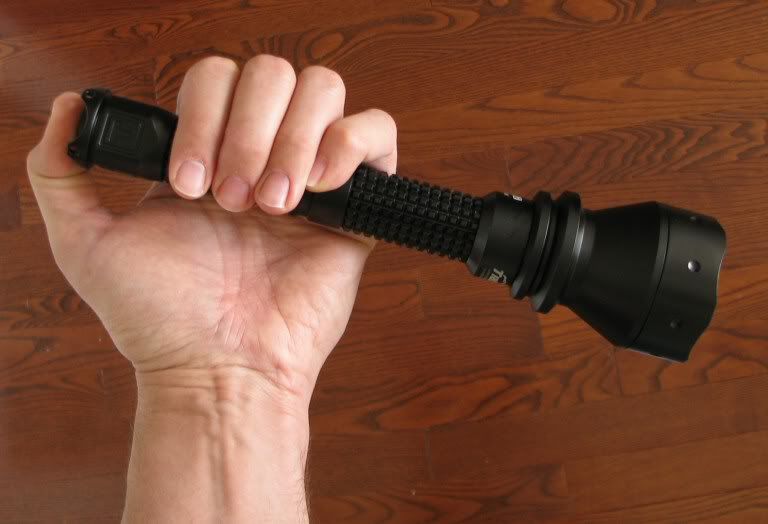
Here is how the common single-stage forward clicky tailcap switch looks: (note that the A10-G also comes with a continuously-variable reverse cliky switch - see Part II for details)
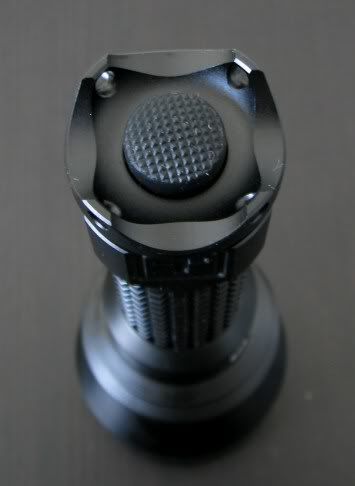
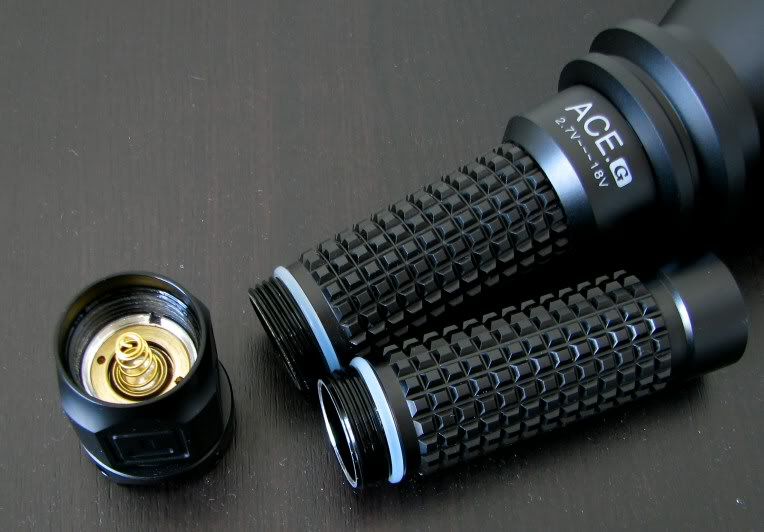
Note the anodized tailcap threads, allowing for tailcap lock-out.
I will cover the User Interface in Parts II & III for each light.
Thanks to the raised edges, the light has several points for lanyard attachment and can tailstand.
Here's the common contact plate in the head: (note the spring)
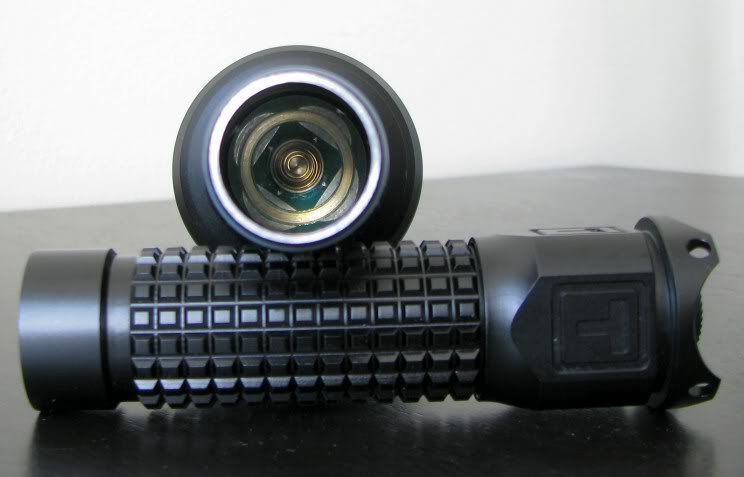
Now how they differ - the reflectors are quite different:
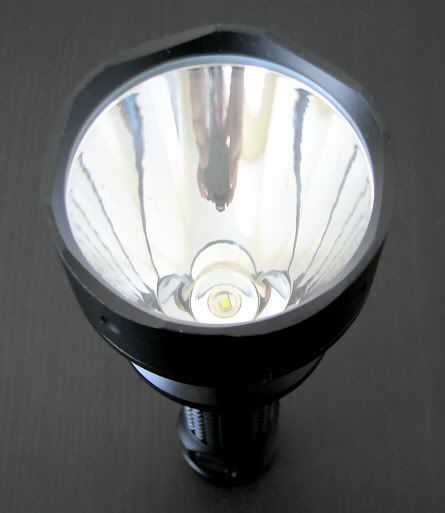
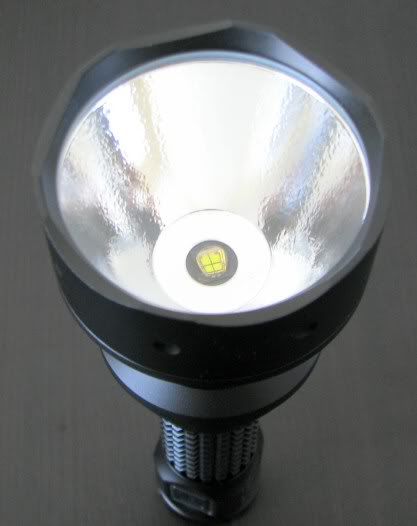
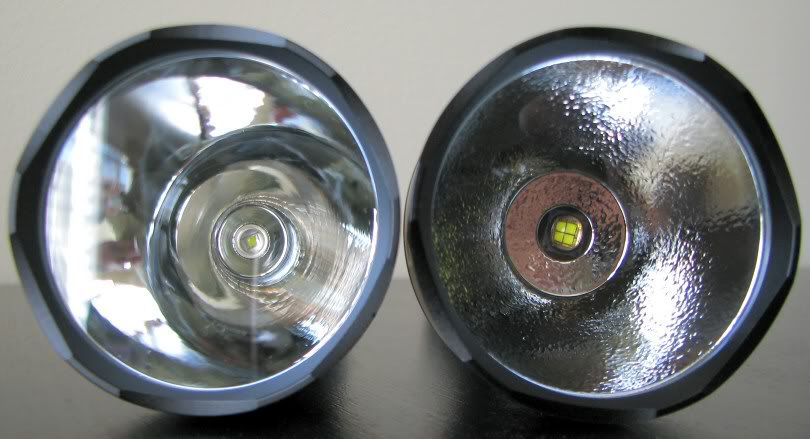
As you can see above, the A10-G comes with a deep smooth reflector (for maximum throw) and the ACE-G comes with a much shallower heavily-textured reflector. The difference in reflector depth is really quite surprising for two lights with an otherwise almost identical build. Here are the reflectors side by side:
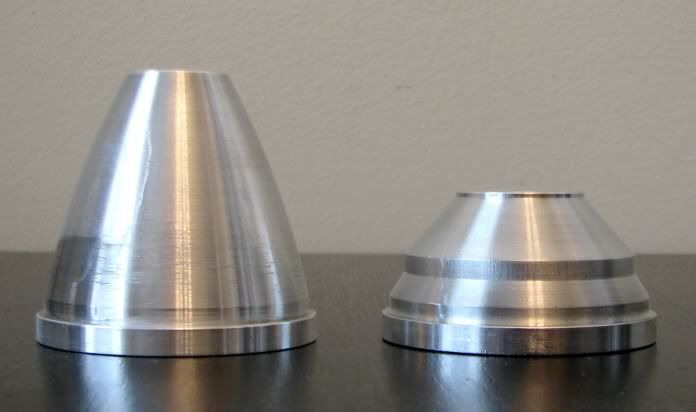
As you would expect, the emitter/pill needs be raised a lot higher on the ACE-G:
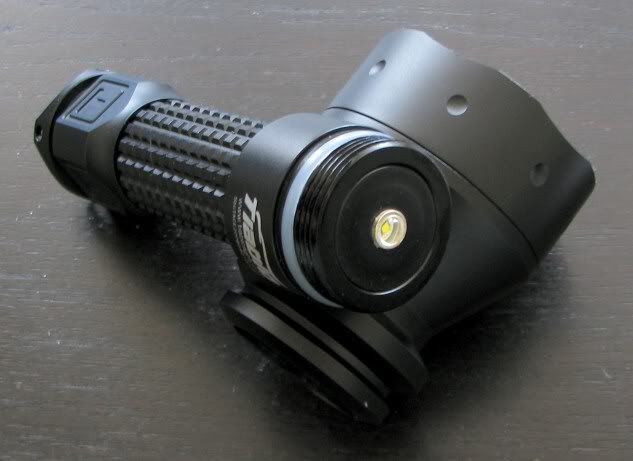
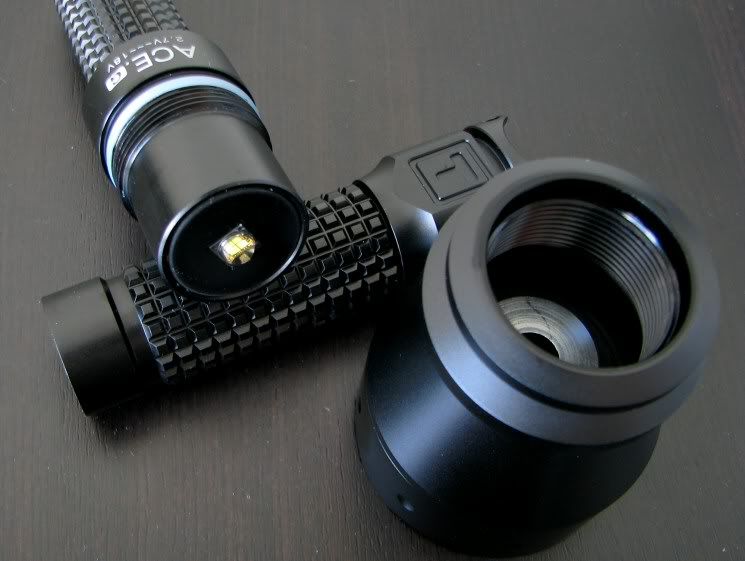
I'm glad to see these design features, since they shows Tiablo has carefully considered the best reflector design for each model. :twothumbs:
Common Dimensions (no batteries installed):
Height: 175mm (243mm with one battery extender)
Width: 31.0mm (tailcap), 25.3mm (body tube), 56.8mm (bezel)
Weight: 248.6g (A10-G), 259.8g (ACE-G), 292.3g (ACE-G with one battery extender)
Personally, I find the overall heft and dimensions of these lights to be fairly good. Although I haven't seen the original A10/ACE, I suspect I would have found them a little bulky, based on other reports.
For detailed beamshots, runtimes, and comparisons to other lights, please scroll down to Parts II & III of this review. In the meantime, here's a quick pair of comparison shots showing you the throw/spill pattern outdoors: (click on the images below to bring up higher resolution photos)


You are looking at a point about 30 feet away from the lights. I've chosen a long exposure time to help you compare the overall beam patterns. Of course, the A10G is a much better thrower.
---------------------------------
PART II - A10-G Comparison Review
Specs (from the Manufacturer):
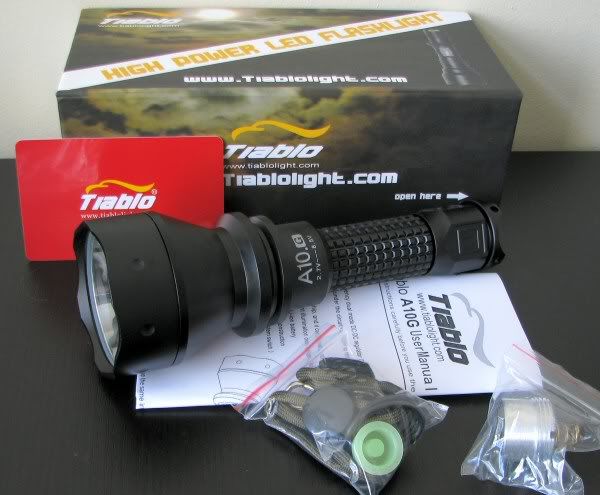
Packaging is similar to other currently shipping Tiablo lights - everything comes in a hard cardboard box with magnetic closing flap. Inside, in cut-out foam, is the light, one-page instruction sheet, warranty card, wrist lanyard, extra o-rings, and continuously-variable switch (single-stage was installed on my sample).
Speaking of the switch, here's how they compare (continuously-variable on left, single-stage on the right). It seems at least come of the circuitry is contained within the switch unit, since swaping it out alters the functionality of the light. :thinking: Note that as usual, you will need snap-ring or fine needle-nose pliers to change the switch (stiff fine-point tweezers might also work):
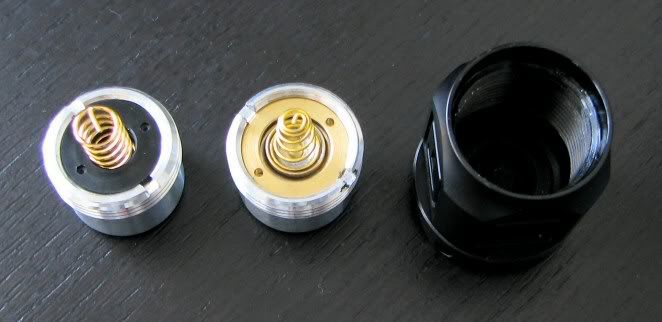
The A10 was designed to replace the previous generation A8/A9 throwers (which shared a common build but different circuits). So how does the new A10-G compare?
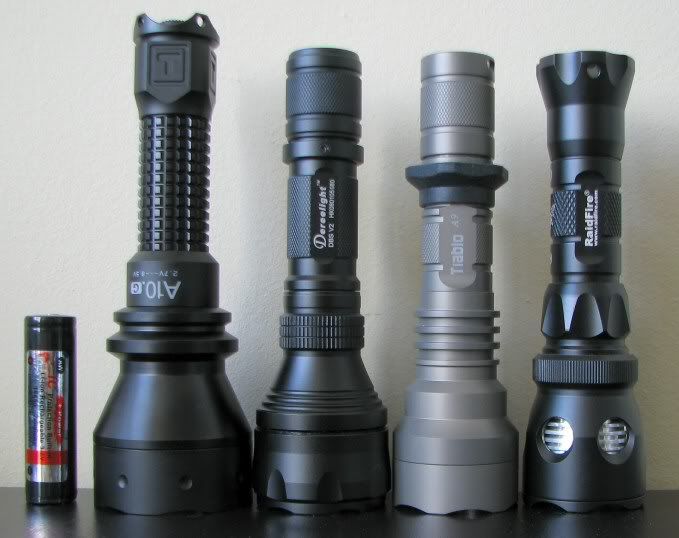
From left to right: 18650 battery, A10-G, Dereelight DBS, Tiablo A9, RaidFire Spear.
Clearly the A10-G is a bit wider at the bezel and taller overall. While I don't find it to be overly large for this class of light, it is definitely not a pocket light. Since the front-end is likely to be what matters, here's a lens-shot comparing to the DBS and Spear:
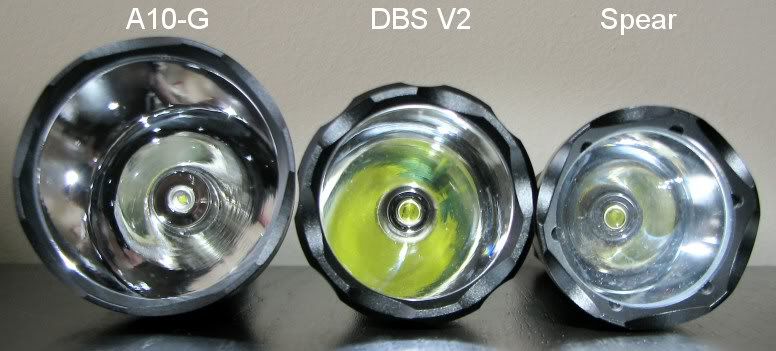
Given the larger overall reflector dimensions, I suspect the A10-G will be tough to beat (more on that in a moment).
User Interface:
User interface is very straight-forward with the single-stage forward clicky installed, just press for momentary on, click for lock-on. :kiss:
With the continuously-variable reverse clicky switch installed, you have two general modes available in sequence - Mode A & B. Click-on turns on the light in Mode A (continuously-variable constant output). To change the output level, press and hold the switch for 3 secs while the light is on - it will now begin ramping down followed by back up, with a double-flash at 50% and a triple-flash at 100% output. You can release the switch at any time once the ramp starts. To select the level you want, you need to click the switch again.
The continuously-variable constant output mode uses PWM, with a detectable frequency of 123Hz in my testing. :sigh:
To access Mode B (Strobe/SOS/Beacon/Continuous), rapidly click and release the switch once from Mode A. To change the setting of Mode B, simply press and hold the switch for 3 secs like above. The mode options run in sequence from fast tactical strobe (13Hz), to a gradually slowing strobe frequency (down to 2Hz), to SOS mode, beacon mode, than a continuously-variable output ramp. Like in Mode A, you can let go of the switch and any point once the sequence of states begins cycling. You will need to click once to select the state you want. Note the strobe/sos modes are at full power, while the beacon mode seems a little less bright to me.
Some peculiarities here: :ironic: you will always move into Mode B from Mode A if you try to shut off the light by the switch (i.e. clicking the switch from A always takes you to B). If you don't want to see Mode B, you will need to twist the tailcap off. This "resets" the switch, and allows you come back on in Mode A next time you click on after re-tightening the switch. But note that this also resets your Mode A to the default max output. It seems the continuously-variable switch requires a constant low current draw to maintain its memory. :sigh: Note too that there is a brief flash of light when tightening the tailcap all the way.
Also note that max output of the continuously-variable reverse clicky is lower than the single-stage forward clicky. Scroll down for a detailed table of outputs/throw.
Comparison Beamshots
All lights are on 100% on 18650 AW protected Li-ion. A10-G is using the single-stage switch for max output. Distance is about 0.5 meters from a white wall.
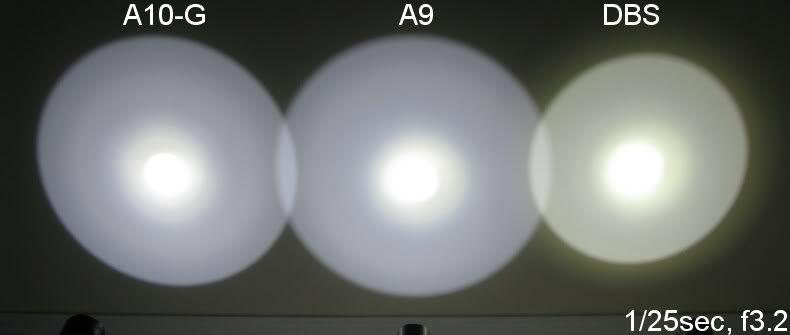
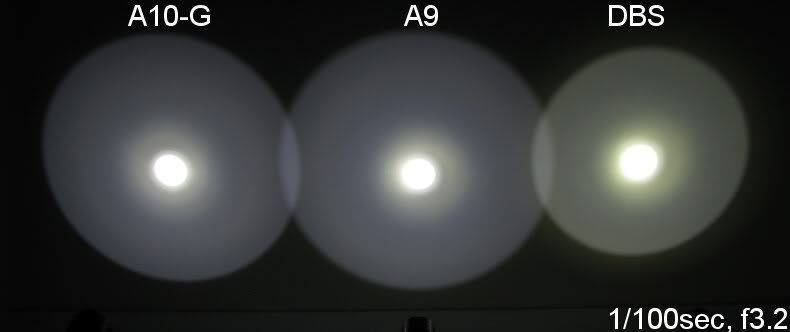
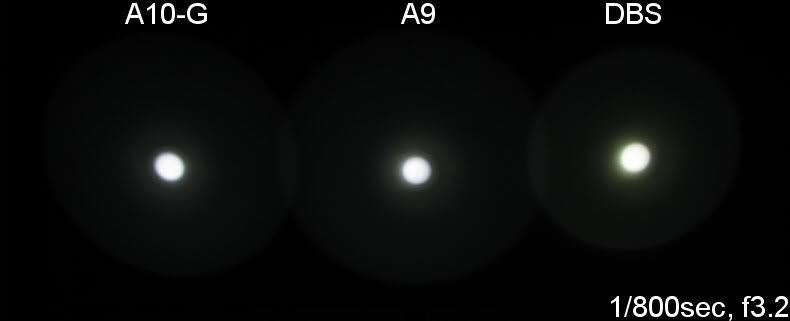
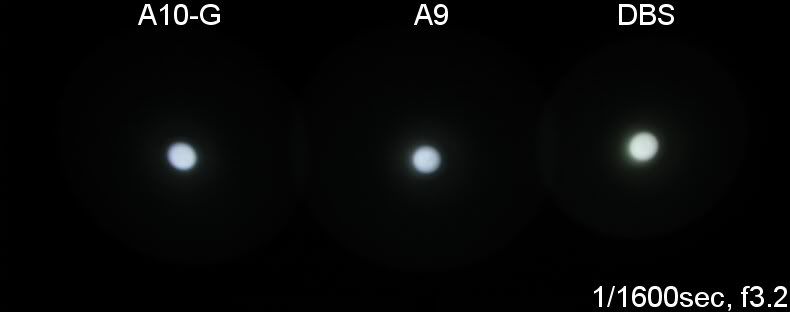
As you can see, the A10-G has a fairly classic thrower beam pattern with a nice tight hotspot and dimmer spill. Detailed throw comparisons will be in the summary table below.
I thought I'd give you some outdoor shots at long exposure to help you better compare the beam patterns. What you are looking at below is a point ~30 feet from the lights.
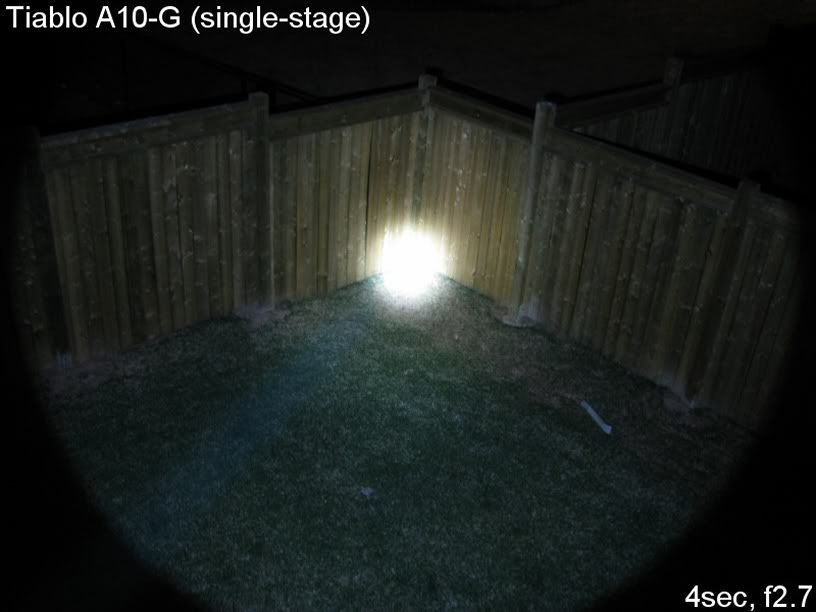
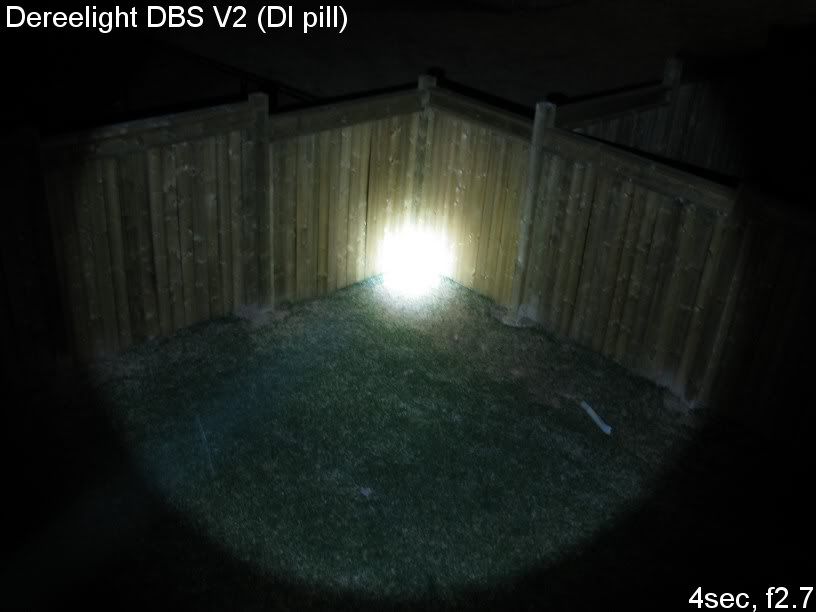
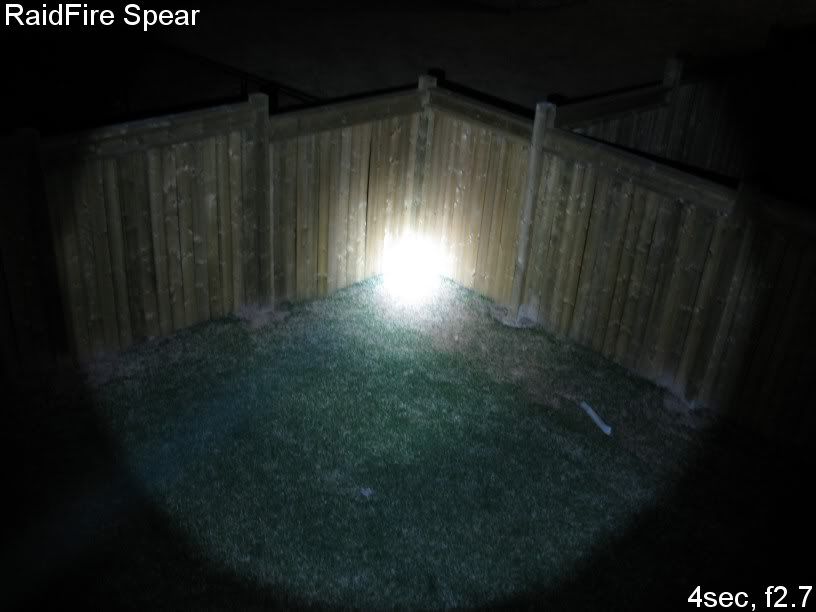
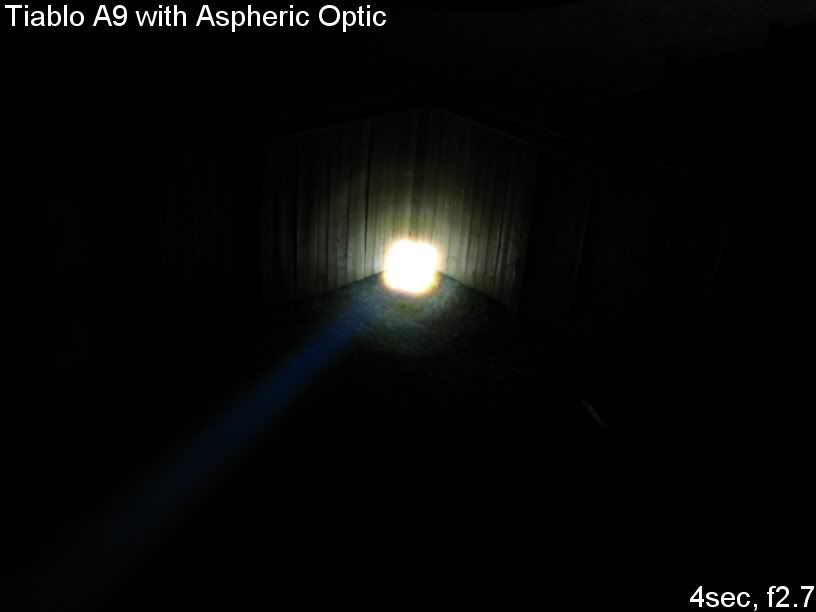
Although exposure is set to show you the spill, you can still infer a lot about throw from these images. Basically, the more light you see in the spillbeam, the less is being directed toward maximum throw. In that regard, the A10-G is clearly the best dedicated thrower among my reflectored lights. I've included the new apherical head for the Tiablo A9 for comparison purposes - this is as close as you can get to a tunnel of light (although with beam artifacts, color distortion, and die image projection). For more details on throw and output, see the Summary Table below.
Testing Method: All my output numbers are relative for my home-made light box setup, a la Quickbeam's flashlightreviews.com method. You can directly compare all my relative output values from different reviews - i.e. an output value of "10" in one graph is the same as "10" in another. All runtimes are done under a cooling fan.
Throw values are the square-root of lux measurements taken at 5 meters from the lens, using a light meter, and then extrapolated back to estimate values for 1 meter.
Throw/Output Summary Chart:
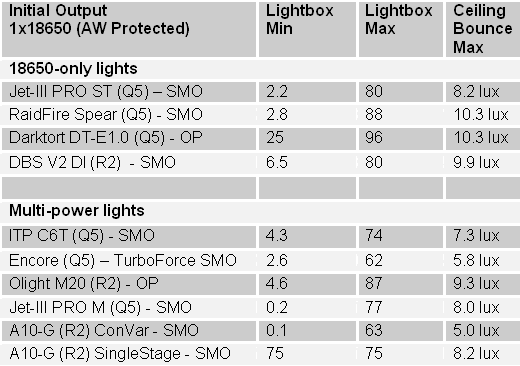
As mentioned previously, overall output of the single-stage switch is brighter than the max output of the continuously-variable switch. Note the dedicated 18650-only lights are typical brighter overall on max output.
But I imagine what you really want to know about is the throw. Even though the A10G doesn't put out quite as much light as some of the others, the bigger and deeper reflector seems to be giving it an advantage. However, I don't believe raw lux at 1 meter (the typical metric) means a lot for these dedicated throwers. The beams don't really have a chance to fully converge until typically several meters out, so what I've done below is taken readings at 5 meters and worked back to a calculated estimate throw/lux at 1 meter. This will be my standard way to present throw on these types of lights from now on.
Even though the A10G doesn't put out quite as much light as some of the others, the bigger and deeper reflector seems to be giving it an advantage. However, I don't believe raw lux at 1 meter (the typical metric) means a lot for these dedicated throwers. The beams don't really have a chance to fully converge until typically several meters out, so what I've done below is taken readings at 5 meters and worked back to a calculated estimate throw/lux at 1 meter. This will be my standard way to present throw on these types of lights from now on.

As you can see, the A10-G on the single-stage switch readily out-throws the reflectored competition, including my DBS (DI pill). Only the aspherical head for the A9 tops it. On the continuously-variable switch, max throw is a bit less than my DBS (also a Cree R2 on a continuously-variable pill).
Only the aspherical head for the A9 tops it. On the continuously-variable switch, max throw is a bit less than my DBS (also a Cree R2 on a continuously-variable pill).
Output/Runtime Comparison
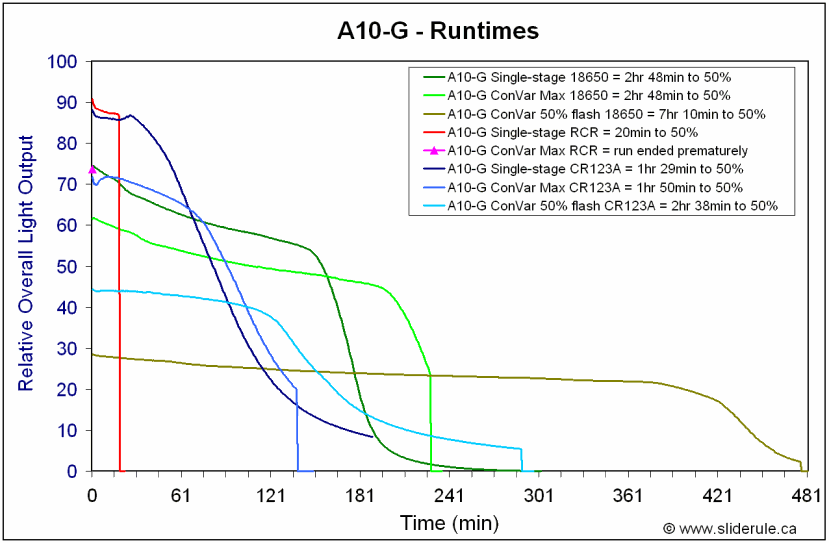
("ConVar" refers to the continuously-variable switch)
Although the published voltage range specs for the A10-G are 2.75V-8.5V, Tiablo only recommends 2xCR123A or 1x18650. I've tested both battery types on both switches, and the results above show that 1x18650 works as expected (scroll down to see a comparison to other lights). 2xCR123A seems to behave normally on Hi, but has some loss of efficiency at the lower outputs.
I decided to test 2xRCR (even though not officially supported), but got inconsistent results. With the single-stage switch, I got 20 mins runtime, indicating a 3C discharge rate (not recommend for Li-ions). This is presumably why Tiablo does not officially support 2xRCR (i.e. their storage capacity is too low). But on the continuously-variable switch, the light cut out within 4 mins into the run on Max, and wouldn't re-ignite for a more than a brief flash on repeated clicks. :shrug: Voltage of the cells was ~4.1V at this point, so I'm not sure of the reason for the failure. Regardless, given the low capacity of these cells, I agree with Tiablo and do NOT recommend you try 2xRCR in this light.
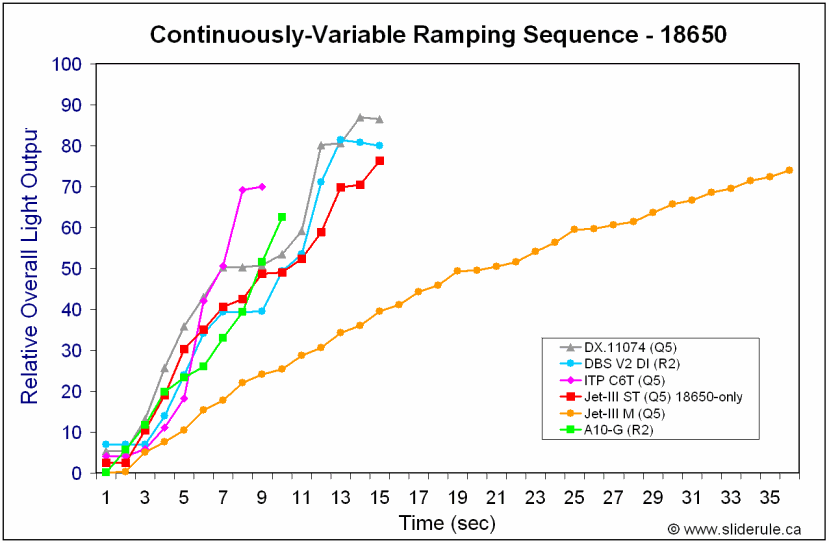
Ramping time is about typical for a continuously-variable light (i.e. 9-10 secs from min to max).
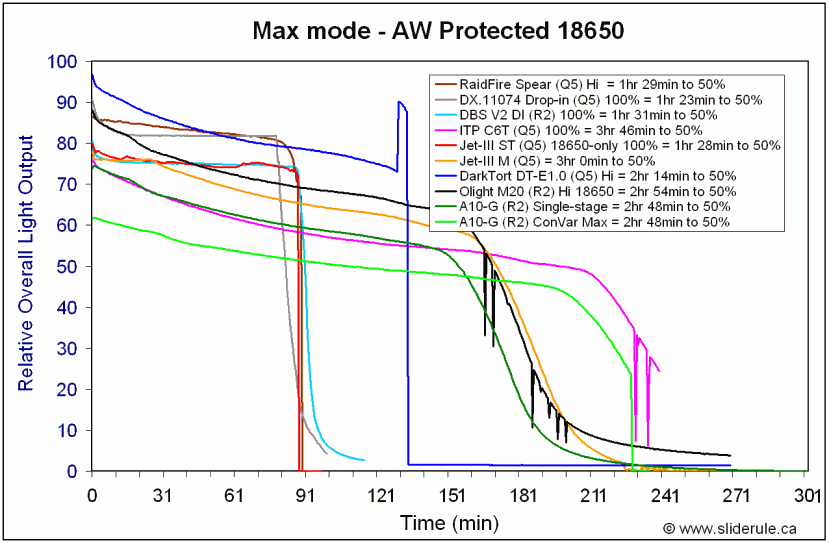
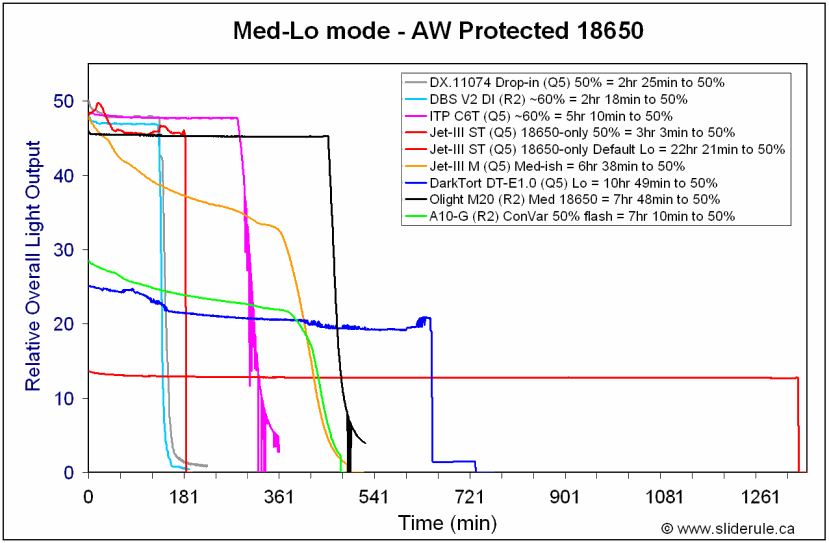
Compared to other lights, runtimes on Max on 18650 seems about typical for a multi-power circuit. Although overall output seems a bit lower than most, this could be an artifact of my lightbox (i.e. really strong throwers tend to score lower than other lights). However, output/runtime efficiency at lower outputs seems a bit lower than some of the other continuously-variable lights (which as a class are all lower than the defined-output constant-current lights).
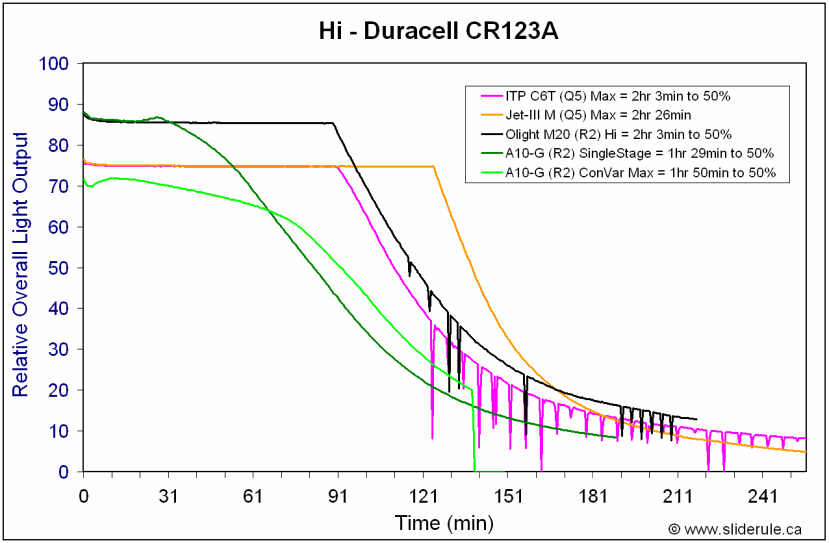
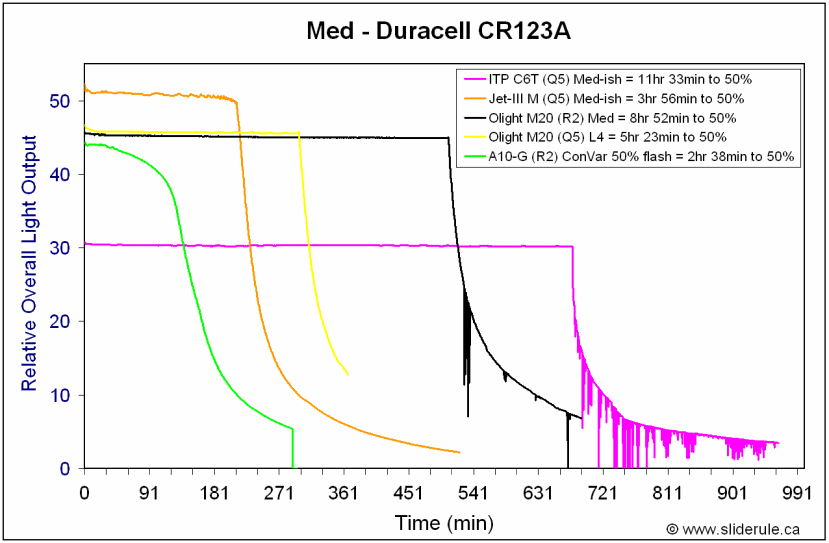
Performance on 2xCR123A definitely seems less efficient than the multi-power competition, especially on lower outputs modes. Of course, a lot of the dedicated throwers are 18650-only lights, so this may still be a benefit to you. :shrug:
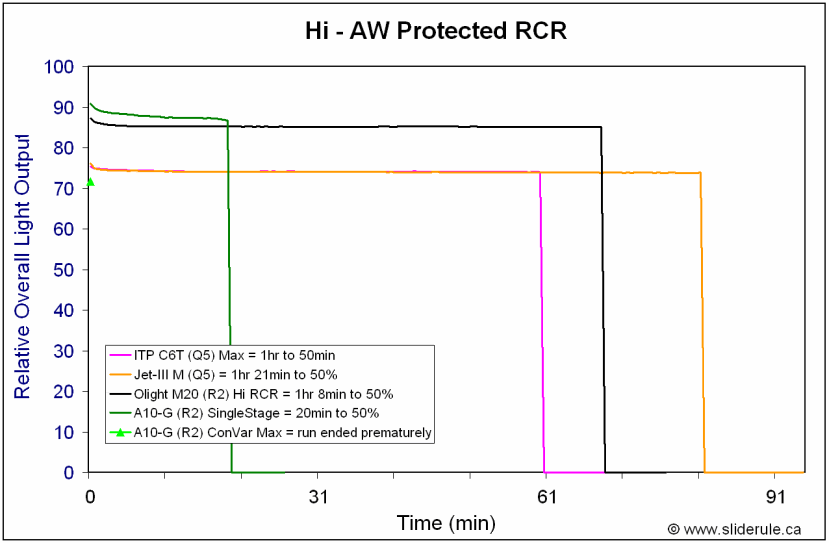
Again, I agree with Tiablo and do not recommend you run the light on 2xRCR.
Potential A10-G Issues
Slightly larger than other dedicated throwers - but with the greatest throw of any of my reflectored lights.
With the continuously-variable switch, there are a number of potential issues:
----------------
PART III - ACE-G Comparison Review
UPDATE 5/8/2009: This section has been updated with results of the newly-revised ACE-G circuit. This version of the circuit is currently on all shipping lights. My original results have been identified below as "Pre-Production" version.
Specs (from the Manufacturer):
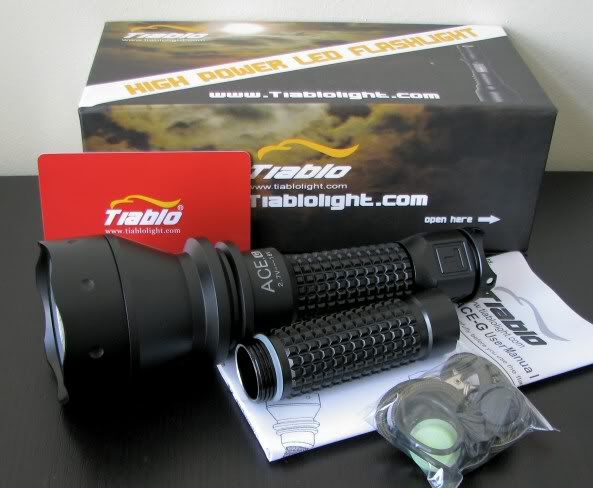
Packaging is identical to the A10-G - everything comes in a hard cardboard box with magnetic closing flap. Inside, in cut-out foam, is the light, one-page instruction sheet, warranty card, wrist lanyard, extra o-rings, and one battery extender tube.
Note that although not officially supported, 3x18650 and even 4x18650 should be possible with additional battery extender tubes, given the working voltage. I haven't tested this, so can't say for certain. Additional battery extender tubes are available from Tiablo.
Although I have additional M-CE lights on the way, at the moment all I can compare to is the Lumapower MVP 3xCree and MVP Turboforce SSC P7.
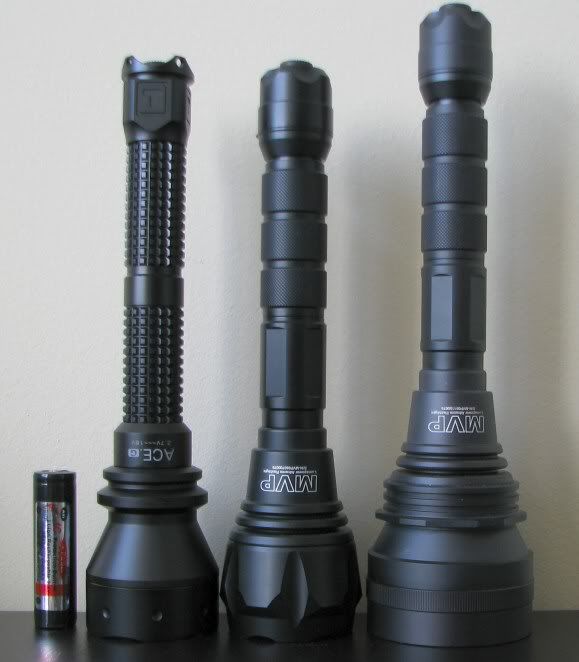
From left to right: 18650 battery, ACE-G, Lumapower MVP 3xCree and MVP Turboforce P7 (all with one optional battery extender in place).
Tiablo ACE-G:
Height: 175mm without extender, 243mm with one battery extender
Width: 31.0mm (tailcap), 25.3mm (body tube), 56.8mm (bezel)
Weight (without batteries): 260g without extender, 292g with one battery extender
MVP 3xCree:
Height: 170mm without extender, 238mm with extender
Width: 58mm max (bezel)
Weight (without batteries): 329g without extender, 385g with extender
MVP TurboForce P7:
Length: 200mm without extender, 265mm with extender
Width: 71mm max (bezel)
Weight (without batteries): 405g without extender, 459g with extender
As you can see, the Tiablo ACE-G is much closer in size to the Lumapower MVP 3xCree than the MVP TurboForce P7. But the ACE-G is noticeably lighter.
Here's a lens-shot comparing to the three lights:
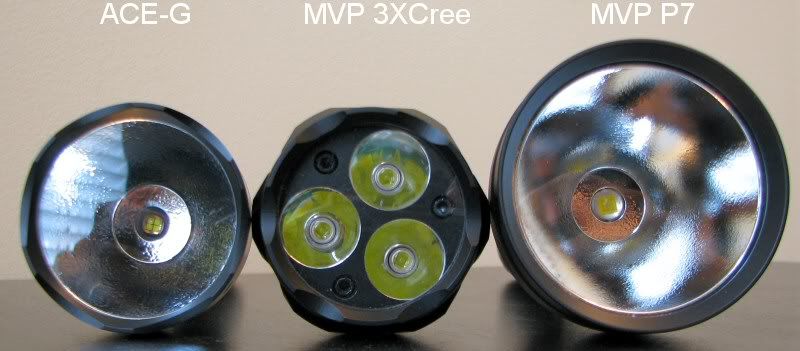
User Interface:
User interface of ACE-G is very straight-forward with the single-stage forward clicky installed, just press for momentary on, click for lock-on. This light is single-stage only, unlike the multi-stage Lumapower lights (which have side-mounted SideKick switches).
Comparison Beamshots
Both lights are on 100% on 2x18650 AW protected Li-ion. Distance is about 0.5 meters from a white wall.
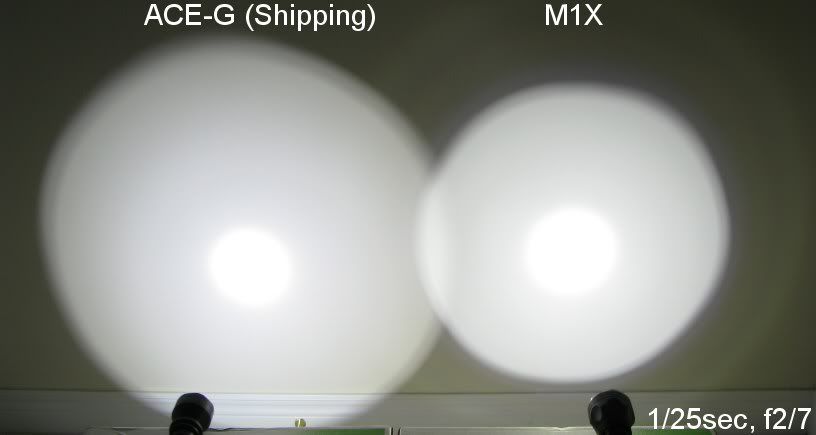
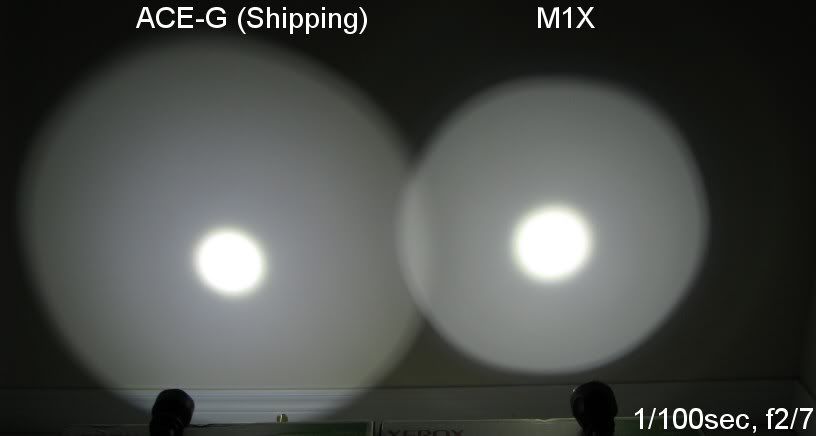
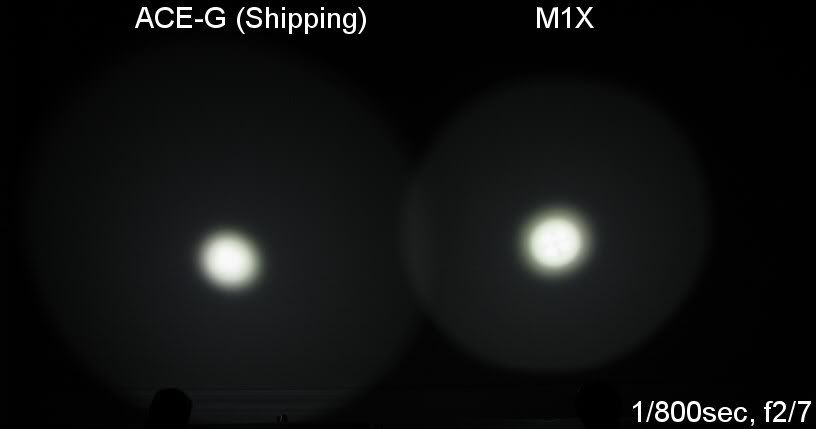
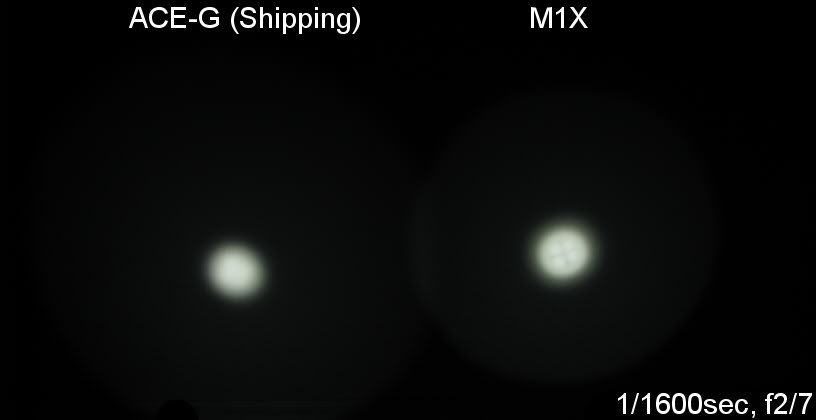
As you can see, the ACE-G has a similar level of output as the JetBeam M1X, but a more "traditiona" MC-E/P7 profile (i.e. similar to the MVP Turboforce P77). Note that the ACE-G reflector is doing a great job on the beam, as there is no center-beam "donut" hole visible in actual use (as opposed the M1X, which has a pronounced donut at distance and a crosshair pattern up close).
For the outdoor shots, these are done at long exposure to help you better compare the beam patterns. What you are looking at below is a point ~30 feet from the lights.
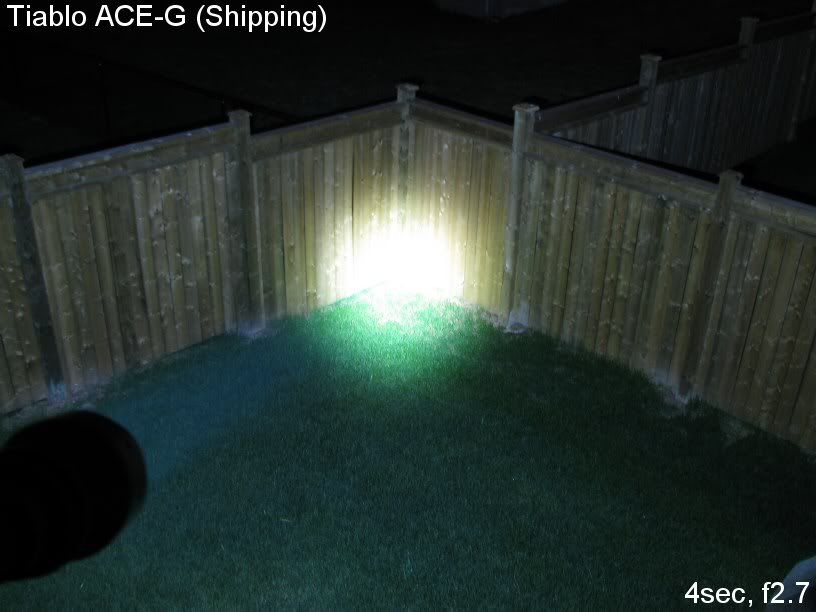
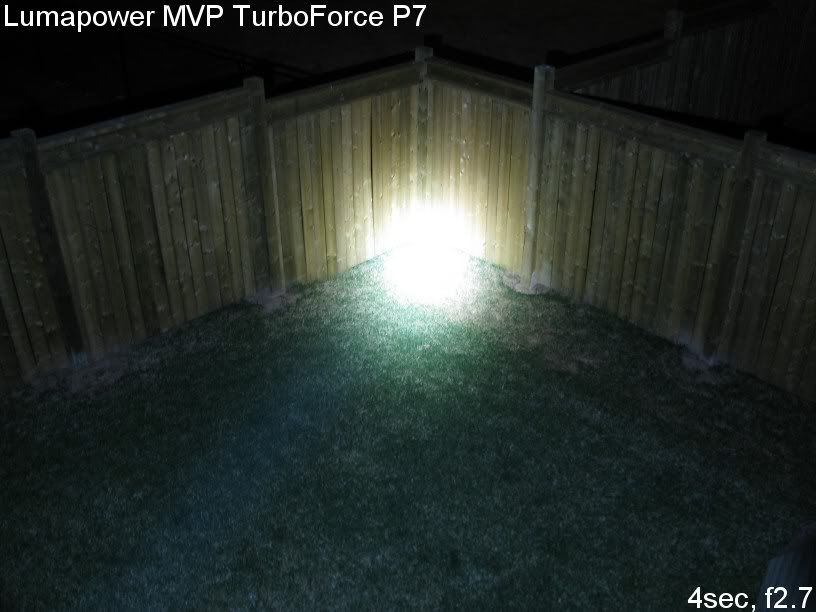
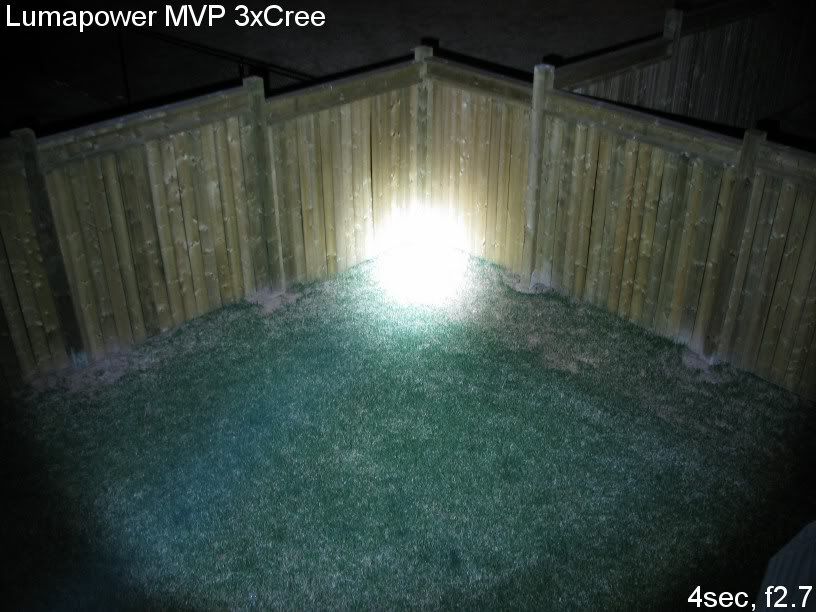
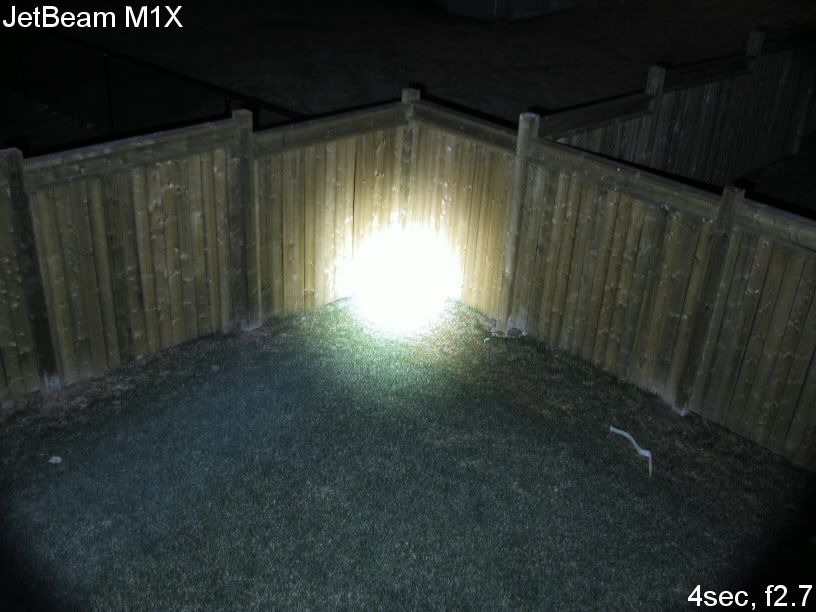
Although the MVP 3xCree may look a brighter, this isn't really the case - the spillbeams of the MVP Turboforce P7 and ACE-G are wider than the field of view of the camera when placed at the same distance from the target. Both the MVP P7 and ACE-G fully light up my yard, while the MVP 3xCree's spill is confined to only a portion of it (and hence will seem brighter in the pics). Like the MVP 3XCree, the JetBeam M1X's spill is similarly constrained to a narrower range.
UPDATE: Here are some lower exposures to show you the hotspot:
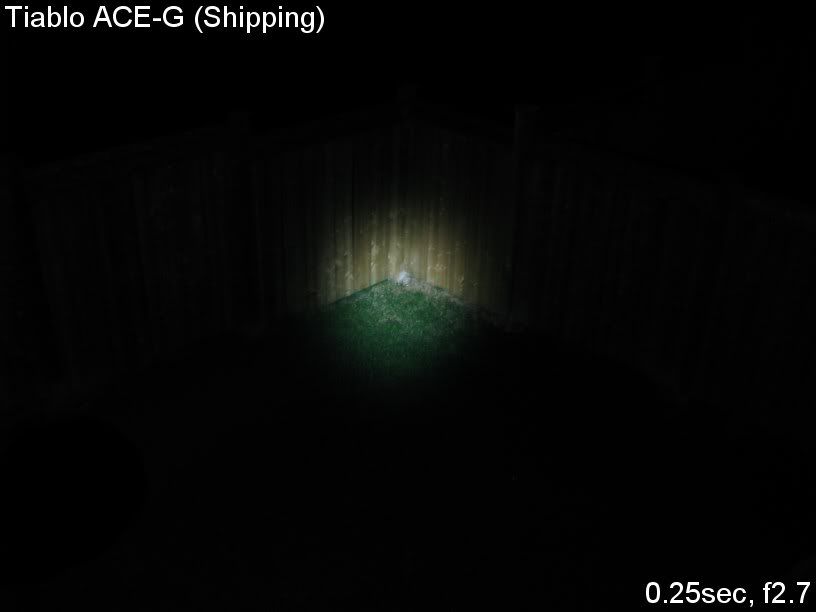
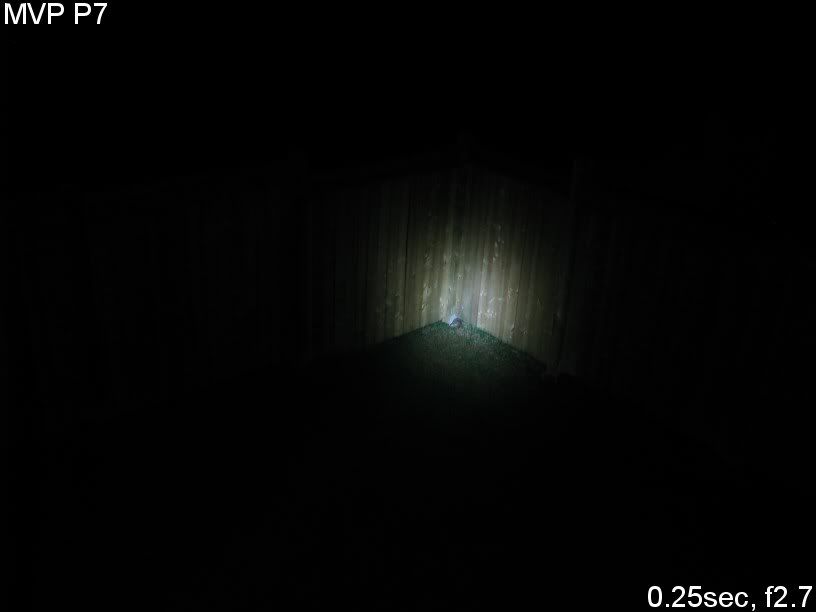
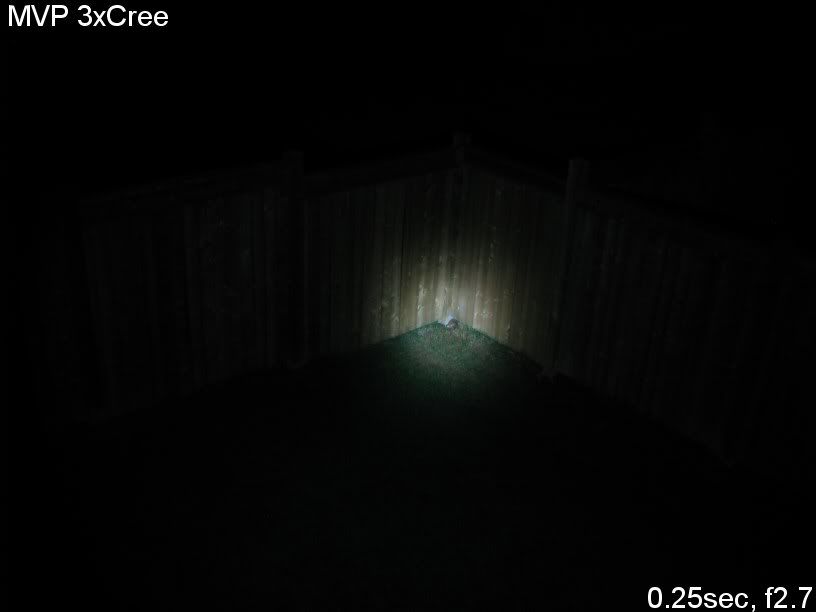
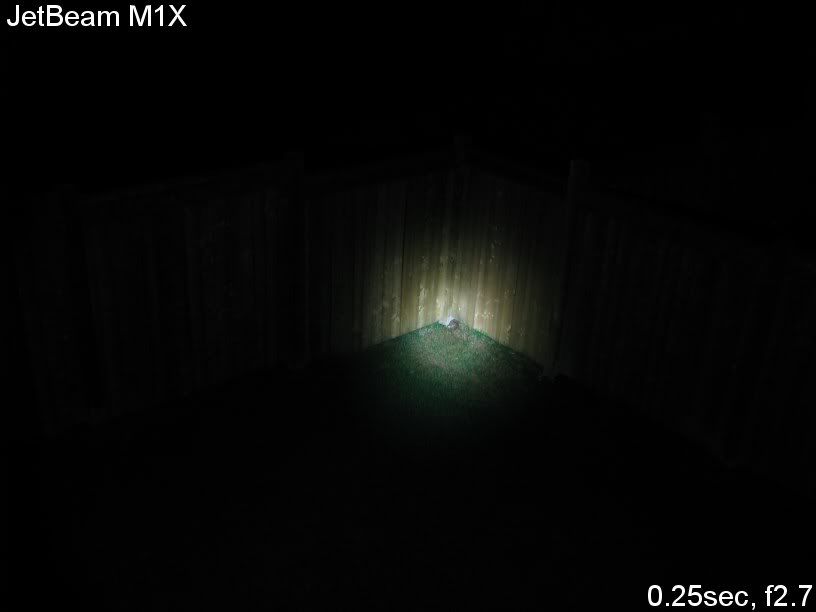
As you can see, the M1X has the greatest throw, while the ACE-G has the smoothest and most even beam. What you can't see so well is the donut hole on both the M1X and MVP P7 - but it is there (and completely lacking from the ACE-G). :thumbsup:
Testing Method: All my output numbers are relative for my home-made light box setup, a la Quickbeam's flashlightreviews.com method. You can directly compare all my relative output values from different reviews - i.e. an output value of "10" in one graph is the same as "10" in another. All runtimes are done under a cooling fan.
Throw values are the square-root of lux measurements taken at 5 meters from the lens, using a light meter, and then extrapolated back to estimate values for 1 meter.
Throw/Output Summary Chart:
Like before, I don't believe raw lux at 1 meter means a lot for these heavy throwers. The beams don't really have a chance to fully converge until typically several meters out, so what I've done below is taken readings at 5 meters and worked back to a calculated estimate throw/lux at 1 meter. This will be my standard way to present throw on these types of lights from now on.
Output and throw measures for these lights are taken after 2 mins of continuous runtime, to let the output of each light settle to its regulated level.
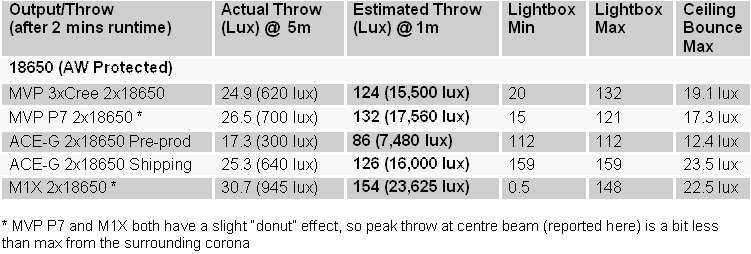
The ACE-G is clearly not a huge thrower compared to the other lights (as expected with the much smaller and shallower reflector). But it also lacks any noticeable center-beam "donut", which is quite prominent on my MVP P7. :thumbsup:
UPDATE 5/8/2009: As you can see above, throw and overall output is greatly increased on the revised shipping version of the ACE-G.
Output/Runtime Comparison
In order show you difference between the original pre-production ACE-G reviewed here and the new shipping version, I have left both sets of traces on the summary runtime graph below.
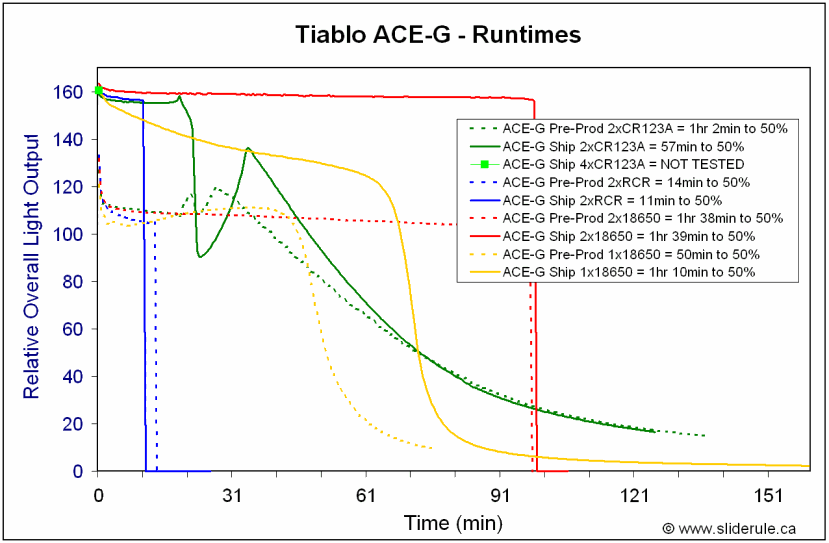
Now that's impressive - overall output has increased by ~50% with no real change in runtime. oo:
oo:
In fact, performance on 1x18650 has actually improved. This is very impressive, since few MC-E lights will run on a single 18650. Performance on 2x18650 and 2xCR123A are now excellent, IMO. :thumbsup:
Also note that there is no longer a steep drop-off in initial output, as was seen on the pre-production ACE-G. This revised shipping version is quite an improvement in regulation and output/runtime efficiency.
But like before, 2xRCR is not recommend on this light - runtime above suggests a >4C discharge rate! Part of the issue may be the state of my RCRs ... all these heavy-drain runtime tests are likely taking their toll on their available capacity. Regardless, I recommend you skip the 2xRCR configuration.
Part of the issue may be the state of my RCRs ... all these heavy-drain runtime tests are likely taking their toll on their available capacity. Regardless, I recommend you skip the 2xRCR configuration.
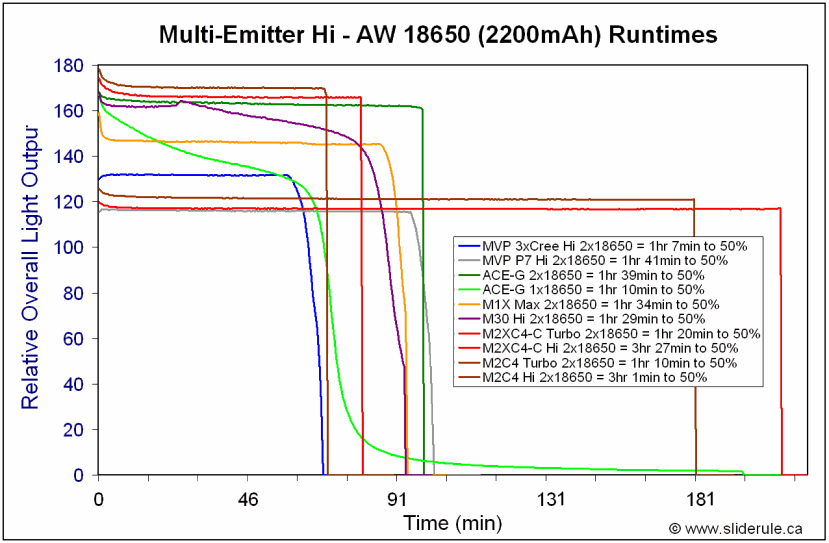
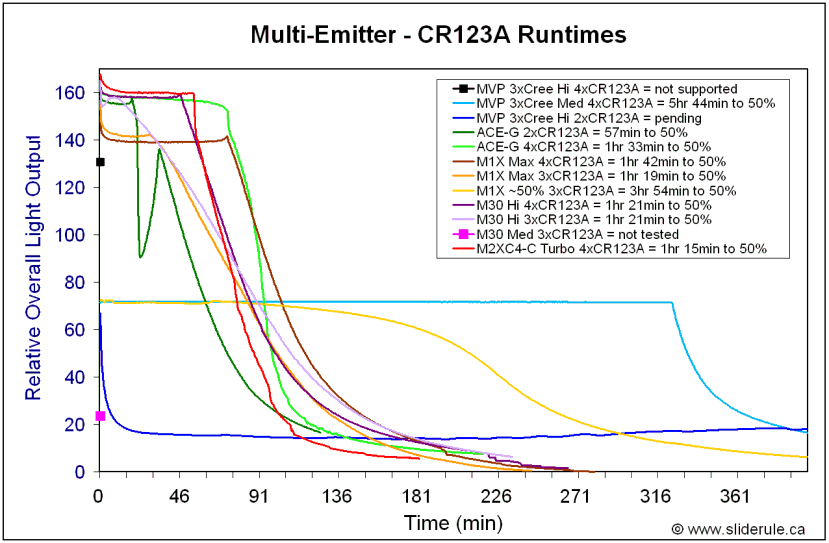
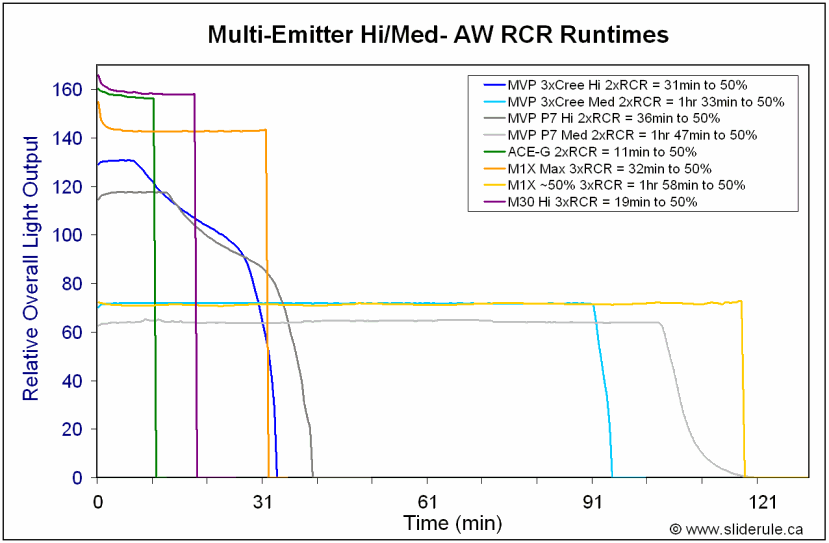
As you can see, performance of the revised shipping circuit is now very competitive for this class of light.
Althought 2xRCR is out in my opinion, I have no issue with 2xCR123A (although difficult to compare to the other lights where 2xCR123A isn't fully supported). And since my Lumapower lights don't support 4xCR123A, I haven't run this test on the ACE-G (which does officially support it).
UPDATE 06/08/09: I've just updated the graphs with 4xCR123A runtimes for all lights that support this configuration. Also included are some recent additions to the multi-emitter class that I have recently reviewed.
Potential A10-G Issues
2xRCR not recommended due to excessive current draw.
-------------------
Preliminary A10-G and ACE-G Observations
There's a lot of info presented above, and I won't even try to summarize it all here. But a few thoughts stand out in my mind.
First off, I like the build features of these lights. The lights are not as heavy as they look, thanks to Tiablo's slim-downed body construction on these new -G models. They both have very good "hand feel" - i.e. not too bulky, not too heavy, and with just the right amount of "gripability" for my tastes.
The lights are not as heavy as they look, thanks to Tiablo's slim-downed body construction on these new -G models. They both have very good "hand feel" - i.e. not too bulky, not too heavy, and with just the right amount of "gripability" for my tastes.
Yes, the A10-G is a bit bigger than its typical thrower-class competition, but it doesn't feel too large to me. It definitely has the best throw of any reflector-based light in my collection (with single-stage switch installed). Of course, the A9 with aspheric head out-throws it, but I consider this more of a toy to play with (given the color variations and die projection issues common to these aspheric optics).
The ACE-G feels just about perfect to me. Similar in size to the MVP 3xCree (which has a form factor I prefer over the larger MVP TurboForce P7), but not quite as heavy. I realize this is highly subjective - those of you used to carrying around 3+ D-cell Mags won't quibble over a few grams - but I like the lower weight of the ACE-G. I also really like how well it performs on just one 18650 - good to have to the option if size is an issue. And I'm very impressed at the lack of a center beam "donut" with this reflector - well done.
- but I like the lower weight of the ACE-G. I also really like how well it performs on just one 18650 - good to have to the option if size is an issue. And I'm very impressed at the lack of a center beam "donut" with this reflector - well done. 
I also like the commitment to multi-power support on both lights. The common single-stage switch is generally a good performer, well optimized for maximum output on 18650 Li-ions, but flexible enough to take other power sources. But it is only a single stage of output, and I would prefer to see at least a couple of defined output levels on both lights.
I am not as impressed with the continously-variable switch on the A10-G. It suffers from visible PWM frequency, reduced max output, relatively poor output/runtime efficiency on 2xCR123A, and needs to draw a current to maintain its memory state. :shakehead I feel like I'm in a bit of time-warp here, as this is the third light I've reviewed this year that has visible PWM (in comparison, most lights released in 2008 had undetectably high levels). This is a disappointing step backwards, and I would urge Tiablo to see what they can do to bump it up. Improved efficiency on primary CR123A should also be a priority. I do like the variable frequency strobe modes on this switch (i.e. from 13Hz down to 2Hz), but am not crazy about the mode switching interface (i.e. always having to pass through Mode B when clicking off, unless you twist the tailcap to break the current and reset the switch).
Loss of official 2xRCR support on the A10-G is not really an issue for me, since I don't believe these sorts of powerhouses should ever be run that way (i.e. the low battery capacity of protected RCR means an unacceptably high discharge rate). I think Tiablo was wise to not "officially" support it on the A10-G, although the voltage range technically allows it (just not on my continously-variable switch, for some reason).
I get the feeling the P7/M-CE flashlight world is going to get a bit more crowded in the near future, so it will be interesting to see what other makers bring to the plate. With their newly revised -G design, I think Tiablo now has a strong body build platform to work from. I encourage them to further refine their circuit designs. But if you are looking for a keep-it-simple, single-stage light to run primarily on 18650, these offerings may have what you are looking for.
UPDATE 5/8/2009: As shown above, the revised ACE-G circuit that is now shipping has greatly improved output and regulation, for equivalent (or better) runtime. This is a very impressive showing for the ACE-G. :thumbsup:
Good night all! :tired:
Warning: very pic heavy, nearly 60 images
UPDATE 5/8/2009: Based on output results presented here, Tiablo realized that there was an issue with the performance of the ACE-G. They were able to revise the circuit before shipping to improve output by nearly 50% with equivalent runtime.
UPDATE 4/28/2009: Added beamshots and runtimes of the JetBeam M1X to the ACE-G comparison portion of this review (Part III).
Tiablo made a bit of splash with their return to the thrower market last year with the A10 (and subsequent ACE, which used the same build but with a quad-die MC-E emitter). I hadn't previously reviewed those lights, but Tiablo has sent be the revised A10-G and ACE-G for comparative review (the "-G" refers to revised size to fit the standard 1-inch diameter of most gun mounts).
Since there are a lot of build similarities, I thought I would cover these two lights together in one massive multi-part review. In the first section (Part I), I will describe the common build features (and differences) of the two lights. In Part II, I will give a detailed comparison of the A10-G to other throwers. And in Part III, I will examine the ACE-G in detail.
-----------------------
PART I - Overview of the A10-G/ACE-G
You will find detailed specs in the Tiablo sales thread for these lights and in Parts II & III of this review, but here is a brief summary of what has changed from the previous generation A10/ACE:
- Body diameter has been reduced to 1 inch on both lights, allowing a standard gun mount to be used.
- Brass sleeve previously present on both lights has been removed.
- Overall weight has been reduced on both lights.
- Revised reflector for the ACE-G (supposedly for a tighter focused beam)
- Wider voltage range for the ACE-G (2.7V-18V), support a broader range of batteries (i.e. from 1x18650 up to 4xCR123A)


From the outside, the A10-G and ACE-G look indistinguishable. The body parts (except for the reflector and emitter/pill) are generally interchangeable between the models. The ACE-G comes with one free battery extender tube, allowing you to use 2x18650 (although additional extenders are available - for up to 4x18650!


The use of a raised checkered pattern (instead of traditional knurling) is an interesting way to enhance grip. Similar to the Olight M20, but more aggressive in this case (i.e. more raised). The battery extenders for the ACE-G now match the rest of the body design.
The lights come in black type-III (hard anodized) finish. The lettering is clear and sharp on my samples (although could be a bit brighter on the small print).
I will cover the comparisons to other lights of their respective classes in Parts II & III, but here's how they look in hand: (note for all the pics below, the A10-G is always shown first, followed by the ACE-G)


Here is how the common single-stage forward clicky tailcap switch looks: (note that the A10-G also comes with a continuously-variable reverse cliky switch - see Part II for details)


Note the anodized tailcap threads, allowing for tailcap lock-out.
I will cover the User Interface in Parts II & III for each light.
Thanks to the raised edges, the light has several points for lanyard attachment and can tailstand.
Here's the common contact plate in the head: (note the spring)

Now how they differ - the reflectors are quite different:



As you can see above, the A10-G comes with a deep smooth reflector (for maximum throw) and the ACE-G comes with a much shallower heavily-textured reflector. The difference in reflector depth is really quite surprising for two lights with an otherwise almost identical build. Here are the reflectors side by side:

As you would expect, the emitter/pill needs be raised a lot higher on the ACE-G:


I'm glad to see these design features, since they shows Tiablo has carefully considered the best reflector design for each model. :twothumbs:
Common Dimensions (no batteries installed):
Height: 175mm (243mm with one battery extender)
Width: 31.0mm (tailcap), 25.3mm (body tube), 56.8mm (bezel)
Weight: 248.6g (A10-G), 259.8g (ACE-G), 292.3g (ACE-G with one battery extender)
Personally, I find the overall heft and dimensions of these lights to be fairly good. Although I haven't seen the original A10/ACE, I suspect I would have found them a little bulky, based on other reports.
For detailed beamshots, runtimes, and comparisons to other lights, please scroll down to Parts II & III of this review. In the meantime, here's a quick pair of comparison shots showing you the throw/spill pattern outdoors: (click on the images below to bring up higher resolution photos)


You are looking at a point about 30 feet away from the lights. I've chosen a long exposure time to help you compare the overall beam patterns. Of course, the A10G is a much better thrower.
---------------------------------
PART II - A10-G Comparison Review
Specs (from the Manufacturer):
- CREE 7090 XR-E LED. WC R2 LED
- Step up and down constant current driver, with high efficiency dual mode DC-DC regulator (PWM / PFM) and circuit to protect Li-ion battery from over-discharging. Working voltage is 2.75V to 8.5V, under the circuit will flicker to remind users to replace battery.
- High output: 1A at 260 Lumens for 3.5 hours (single-stage switch)
- Function: multifunctional circuit with advanced Mini computer chip, and it can set according to customers' variety requirement (reverse-stage continuously-variable switch)
- 53 mm diameter x 50 mm deep reflector provides greater efficient illumination over longer distances than the standard with similar power
- Support battery sizes Two 3.0V CR123A batteries or one 18650 Li-ion battery
- Type-III hard anodize high quality aerospace grade T7075 aluminium construction
- Switch: Tactical forward clicky switch for single-stage, reverse clicky for continuously-variable
- Waterproof Capability: IPX-8 standard
- Toughened ultra clear glass lens with AR coating
- Weight: 180 g
- Length: 175mm Head diameter: 57mm Housing Diameter: 25.4mm

Packaging is similar to other currently shipping Tiablo lights - everything comes in a hard cardboard box with magnetic closing flap. Inside, in cut-out foam, is the light, one-page instruction sheet, warranty card, wrist lanyard, extra o-rings, and continuously-variable switch (single-stage was installed on my sample).
Speaking of the switch, here's how they compare (continuously-variable on left, single-stage on the right). It seems at least come of the circuitry is contained within the switch unit, since swaping it out alters the functionality of the light. :thinking: Note that as usual, you will need snap-ring or fine needle-nose pliers to change the switch (stiff fine-point tweezers might also work):

The A10 was designed to replace the previous generation A8/A9 throwers (which shared a common build but different circuits). So how does the new A10-G compare?

From left to right: 18650 battery, A10-G, Dereelight DBS, Tiablo A9, RaidFire Spear.
Clearly the A10-G is a bit wider at the bezel and taller overall. While I don't find it to be overly large for this class of light, it is definitely not a pocket light. Since the front-end is likely to be what matters, here's a lens-shot comparing to the DBS and Spear:

Given the larger overall reflector dimensions, I suspect the A10-G will be tough to beat (more on that in a moment).
User Interface:
User interface is very straight-forward with the single-stage forward clicky installed, just press for momentary on, click for lock-on. :kiss:
With the continuously-variable reverse clicky switch installed, you have two general modes available in sequence - Mode A & B. Click-on turns on the light in Mode A (continuously-variable constant output). To change the output level, press and hold the switch for 3 secs while the light is on - it will now begin ramping down followed by back up, with a double-flash at 50% and a triple-flash at 100% output. You can release the switch at any time once the ramp starts. To select the level you want, you need to click the switch again.
The continuously-variable constant output mode uses PWM, with a detectable frequency of 123Hz in my testing. :sigh:
To access Mode B (Strobe/SOS/Beacon/Continuous), rapidly click and release the switch once from Mode A. To change the setting of Mode B, simply press and hold the switch for 3 secs like above. The mode options run in sequence from fast tactical strobe (13Hz), to a gradually slowing strobe frequency (down to 2Hz), to SOS mode, beacon mode, than a continuously-variable output ramp. Like in Mode A, you can let go of the switch and any point once the sequence of states begins cycling. You will need to click once to select the state you want. Note the strobe/sos modes are at full power, while the beacon mode seems a little less bright to me.
Some peculiarities here: :ironic: you will always move into Mode B from Mode A if you try to shut off the light by the switch (i.e. clicking the switch from A always takes you to B). If you don't want to see Mode B, you will need to twist the tailcap off. This "resets" the switch, and allows you come back on in Mode A next time you click on after re-tightening the switch. But note that this also resets your Mode A to the default max output. It seems the continuously-variable switch requires a constant low current draw to maintain its memory. :sigh: Note too that there is a brief flash of light when tightening the tailcap all the way.
Also note that max output of the continuously-variable reverse clicky is lower than the single-stage forward clicky. Scroll down for a detailed table of outputs/throw.
Comparison Beamshots
All lights are on 100% on 18650 AW protected Li-ion. A10-G is using the single-stage switch for max output. Distance is about 0.5 meters from a white wall.




As you can see, the A10-G has a fairly classic thrower beam pattern with a nice tight hotspot and dimmer spill. Detailed throw comparisons will be in the summary table below.
I thought I'd give you some outdoor shots at long exposure to help you better compare the beam patterns. What you are looking at below is a point ~30 feet from the lights.




Although exposure is set to show you the spill, you can still infer a lot about throw from these images. Basically, the more light you see in the spillbeam, the less is being directed toward maximum throw. In that regard, the A10-G is clearly the best dedicated thrower among my reflectored lights. I've included the new apherical head for the Tiablo A9 for comparison purposes - this is as close as you can get to a tunnel of light (although with beam artifacts, color distortion, and die image projection). For more details on throw and output, see the Summary Table below.
Testing Method: All my output numbers are relative for my home-made light box setup, a la Quickbeam's flashlightreviews.com method. You can directly compare all my relative output values from different reviews - i.e. an output value of "10" in one graph is the same as "10" in another. All runtimes are done under a cooling fan.
Throw values are the square-root of lux measurements taken at 5 meters from the lens, using a light meter, and then extrapolated back to estimate values for 1 meter.
Throw/Output Summary Chart:

As mentioned previously, overall output of the single-stage switch is brighter than the max output of the continuously-variable switch. Note the dedicated 18650-only lights are typical brighter overall on max output.
But I imagine what you really want to know about is the throw.

As you can see, the A10-G on the single-stage switch readily out-throws the reflectored competition, including my DBS (DI pill).
 Only the aspherical head for the A9 tops it. On the continuously-variable switch, max throw is a bit less than my DBS (also a Cree R2 on a continuously-variable pill).
Only the aspherical head for the A9 tops it. On the continuously-variable switch, max throw is a bit less than my DBS (also a Cree R2 on a continuously-variable pill).Output/Runtime Comparison

("ConVar" refers to the continuously-variable switch)
Although the published voltage range specs for the A10-G are 2.75V-8.5V, Tiablo only recommends 2xCR123A or 1x18650. I've tested both battery types on both switches, and the results above show that 1x18650 works as expected (scroll down to see a comparison to other lights). 2xCR123A seems to behave normally on Hi, but has some loss of efficiency at the lower outputs.
I decided to test 2xRCR (even though not officially supported), but got inconsistent results. With the single-stage switch, I got 20 mins runtime, indicating a 3C discharge rate (not recommend for Li-ions). This is presumably why Tiablo does not officially support 2xRCR (i.e. their storage capacity is too low). But on the continuously-variable switch, the light cut out within 4 mins into the run on Max, and wouldn't re-ignite for a more than a brief flash on repeated clicks. :shrug: Voltage of the cells was ~4.1V at this point, so I'm not sure of the reason for the failure. Regardless, given the low capacity of these cells, I agree with Tiablo and do NOT recommend you try 2xRCR in this light.

Ramping time is about typical for a continuously-variable light (i.e. 9-10 secs from min to max).


Compared to other lights, runtimes on Max on 18650 seems about typical for a multi-power circuit. Although overall output seems a bit lower than most, this could be an artifact of my lightbox (i.e. really strong throwers tend to score lower than other lights). However, output/runtime efficiency at lower outputs seems a bit lower than some of the other continuously-variable lights (which as a class are all lower than the defined-output constant-current lights).


Performance on 2xCR123A definitely seems less efficient than the multi-power competition, especially on lower outputs modes. Of course, a lot of the dedicated throwers are 18650-only lights, so this may still be a benefit to you. :shrug:

Again, I agree with Tiablo and do not recommend you run the light on 2xRCR.
Potential A10-G Issues
Slightly larger than other dedicated throwers - but with the greatest throw of any of my reflectored lights.
With the continuously-variable switch, there are a number of potential issues:
- Lower output/runtime efficiency on 2xCR123A compared to other multi-power lights.
- Visible PWM frequency of 123Hz.
- 2xRCR not supported (and not recommended).
- Automatic switching into Mode B when exiting Mode A
- Switch resets state memory when unscrewed, suggesting a constant low current draw is required to maintain memory (i.e. always drawing some power - even when off - unless disconnected)
----------------
PART III - ACE-G Comparison Review
UPDATE 5/8/2009: This section has been updated with results of the newly-revised ACE-G circuit. This version of the circuit is currently on all shipping lights. My original results have been identified below as "Pre-Production" version.
Specs (from the Manufacturer):
- # CREE MC-E (M rank, WC) LED
- Step up and down constant current driver, with two high efficiency dual modes DC-DC regulator (PWM / PFM) and circuit to indicate the Li- ion battery from over-discharging. Working voltage is 2.7V to 18V, with a circuit flicker to remind users to replace battery.
- Max output 700lumen, runtime: 45minutes (1pcs 3000mAh 18650) and 3 hours (2pcs 3000mAh 18650)
- Functions: one level output, easy to use and reliable
- 53 mm diameter x 50 mm deep reflector provides a greater efficient illumination over longer distances
- Supports battery sizes; 2 x 3.0V CR123A batteries, 2 x 17335 Li-ion or one 18650 Li-ion battery, two 18650 Li-ion batteries, 4 x 3.0V CR123A batteries
- Type-III hard anodize high quality aerospace grade T7075 aluminum construction
- Switch: Tactical forward switch (single stage)
- Waterproof Capability: IPX-8 standard
- Toughened ultra clear glass lens with AR coating
- Weight: 230 g
- Length: 175mm Head diameter: 57mm Housing Diameter: 25.4mm

Packaging is identical to the A10-G - everything comes in a hard cardboard box with magnetic closing flap. Inside, in cut-out foam, is the light, one-page instruction sheet, warranty card, wrist lanyard, extra o-rings, and one battery extender tube.
Note that although not officially supported, 3x18650 and even 4x18650 should be possible with additional battery extender tubes, given the working voltage. I haven't tested this, so can't say for certain. Additional battery extender tubes are available from Tiablo.
Although I have additional M-CE lights on the way, at the moment all I can compare to is the Lumapower MVP 3xCree and MVP Turboforce SSC P7.

From left to right: 18650 battery, ACE-G, Lumapower MVP 3xCree and MVP Turboforce P7 (all with one optional battery extender in place).
Tiablo ACE-G:
Height: 175mm without extender, 243mm with one battery extender
Width: 31.0mm (tailcap), 25.3mm (body tube), 56.8mm (bezel)
Weight (without batteries): 260g without extender, 292g with one battery extender
MVP 3xCree:
Height: 170mm without extender, 238mm with extender
Width: 58mm max (bezel)
Weight (without batteries): 329g without extender, 385g with extender
MVP TurboForce P7:
Length: 200mm without extender, 265mm with extender
Width: 71mm max (bezel)
Weight (without batteries): 405g without extender, 459g with extender
As you can see, the Tiablo ACE-G is much closer in size to the Lumapower MVP 3xCree than the MVP TurboForce P7. But the ACE-G is noticeably lighter.
Here's a lens-shot comparing to the three lights:

User Interface:
User interface of ACE-G is very straight-forward with the single-stage forward clicky installed, just press for momentary on, click for lock-on. This light is single-stage only, unlike the multi-stage Lumapower lights (which have side-mounted SideKick switches).
Comparison Beamshots
Both lights are on 100% on 2x18650 AW protected Li-ion. Distance is about 0.5 meters from a white wall.




As you can see, the ACE-G has a similar level of output as the JetBeam M1X, but a more "traditiona" MC-E/P7 profile (i.e. similar to the MVP Turboforce P77). Note that the ACE-G reflector is doing a great job on the beam, as there is no center-beam "donut" hole visible in actual use (as opposed the M1X, which has a pronounced donut at distance and a crosshair pattern up close).
For the outdoor shots, these are done at long exposure to help you better compare the beam patterns. What you are looking at below is a point ~30 feet from the lights.




Although the MVP 3xCree may look a brighter, this isn't really the case - the spillbeams of the MVP Turboforce P7 and ACE-G are wider than the field of view of the camera when placed at the same distance from the target. Both the MVP P7 and ACE-G fully light up my yard, while the MVP 3xCree's spill is confined to only a portion of it (and hence will seem brighter in the pics). Like the MVP 3XCree, the JetBeam M1X's spill is similarly constrained to a narrower range.
UPDATE: Here are some lower exposures to show you the hotspot:




As you can see, the M1X has the greatest throw, while the ACE-G has the smoothest and most even beam. What you can't see so well is the donut hole on both the M1X and MVP P7 - but it is there (and completely lacking from the ACE-G). :thumbsup:
Testing Method: All my output numbers are relative for my home-made light box setup, a la Quickbeam's flashlightreviews.com method. You can directly compare all my relative output values from different reviews - i.e. an output value of "10" in one graph is the same as "10" in another. All runtimes are done under a cooling fan.
Throw values are the square-root of lux measurements taken at 5 meters from the lens, using a light meter, and then extrapolated back to estimate values for 1 meter.
Throw/Output Summary Chart:
Like before, I don't believe raw lux at 1 meter means a lot for these heavy throwers. The beams don't really have a chance to fully converge until typically several meters out, so what I've done below is taken readings at 5 meters and worked back to a calculated estimate throw/lux at 1 meter. This will be my standard way to present throw on these types of lights from now on.
Output and throw measures for these lights are taken after 2 mins of continuous runtime, to let the output of each light settle to its regulated level.

The ACE-G is clearly not a huge thrower compared to the other lights (as expected with the much smaller and shallower reflector). But it also lacks any noticeable center-beam "donut", which is quite prominent on my MVP P7. :thumbsup:
UPDATE 5/8/2009: As you can see above, throw and overall output is greatly increased on the revised shipping version of the ACE-G.
Output/Runtime Comparison
In order show you difference between the original pre-production ACE-G reviewed here and the new shipping version, I have left both sets of traces on the summary runtime graph below.

Now that's impressive - overall output has increased by ~50% with no real change in runtime.
In fact, performance on 1x18650 has actually improved. This is very impressive, since few MC-E lights will run on a single 18650. Performance on 2x18650 and 2xCR123A are now excellent, IMO. :thumbsup:
Also note that there is no longer a steep drop-off in initial output, as was seen on the pre-production ACE-G. This revised shipping version is quite an improvement in regulation and output/runtime efficiency.
But like before, 2xRCR is not recommend on this light - runtime above suggests a >4C discharge rate!



As you can see, performance of the revised shipping circuit is now very competitive for this class of light.
Althought 2xRCR is out in my opinion, I have no issue with 2xCR123A (although difficult to compare to the other lights where 2xCR123A isn't fully supported). And since my Lumapower lights don't support 4xCR123A, I haven't run this test on the ACE-G (which does officially support it).
UPDATE 06/08/09: I've just updated the graphs with 4xCR123A runtimes for all lights that support this configuration. Also included are some recent additions to the multi-emitter class that I have recently reviewed.
Potential A10-G Issues
2xRCR not recommended due to excessive current draw.
-------------------
Preliminary A10-G and ACE-G Observations
There's a lot of info presented above, and I won't even try to summarize it all here. But a few thoughts stand out in my mind.
First off, I like the build features of these lights.
 The lights are not as heavy as they look, thanks to Tiablo's slim-downed body construction on these new -G models. They both have very good "hand feel" - i.e. not too bulky, not too heavy, and with just the right amount of "gripability" for my tastes.
The lights are not as heavy as they look, thanks to Tiablo's slim-downed body construction on these new -G models. They both have very good "hand feel" - i.e. not too bulky, not too heavy, and with just the right amount of "gripability" for my tastes.Yes, the A10-G is a bit bigger than its typical thrower-class competition, but it doesn't feel too large to me. It definitely has the best throw of any reflector-based light in my collection (with single-stage switch installed). Of course, the A9 with aspheric head out-throws it, but I consider this more of a toy to play with (given the color variations and die projection issues common to these aspheric optics).
The ACE-G feels just about perfect to me. Similar in size to the MVP 3xCree (which has a form factor I prefer over the larger MVP TurboForce P7), but not quite as heavy. I realize this is highly subjective - those of you used to carrying around 3+ D-cell Mags won't quibble over a few grams
I also like the commitment to multi-power support on both lights. The common single-stage switch is generally a good performer, well optimized for maximum output on 18650 Li-ions, but flexible enough to take other power sources. But it is only a single stage of output, and I would prefer to see at least a couple of defined output levels on both lights.
I am not as impressed with the continously-variable switch on the A10-G. It suffers from visible PWM frequency, reduced max output, relatively poor output/runtime efficiency on 2xCR123A, and needs to draw a current to maintain its memory state. :shakehead I feel like I'm in a bit of time-warp here, as this is the third light I've reviewed this year that has visible PWM (in comparison, most lights released in 2008 had undetectably high levels). This is a disappointing step backwards, and I would urge Tiablo to see what they can do to bump it up. Improved efficiency on primary CR123A should also be a priority. I do like the variable frequency strobe modes on this switch (i.e. from 13Hz down to 2Hz), but am not crazy about the mode switching interface (i.e. always having to pass through Mode B when clicking off, unless you twist the tailcap to break the current and reset the switch).
Loss of official 2xRCR support on the A10-G is not really an issue for me, since I don't believe these sorts of powerhouses should ever be run that way (i.e. the low battery capacity of protected RCR means an unacceptably high discharge rate). I think Tiablo was wise to not "officially" support it on the A10-G, although the voltage range technically allows it (just not on my continously-variable switch, for some reason).
I get the feeling the P7/M-CE flashlight world is going to get a bit more crowded in the near future, so it will be interesting to see what other makers bring to the plate. With their newly revised -G design, I think Tiablo now has a strong body build platform to work from. I encourage them to further refine their circuit designs. But if you are looking for a keep-it-simple, single-stage light to run primarily on 18650, these offerings may have what you are looking for.
UPDATE 5/8/2009: As shown above, the revised ACE-G circuit that is now shipping has greatly improved output and regulation, for equivalent (or better) runtime. This is a very impressive showing for the ACE-G. :thumbsup:
Good night all! :tired:
Last edited:





 Doh!
Doh!